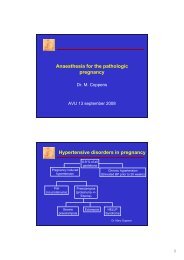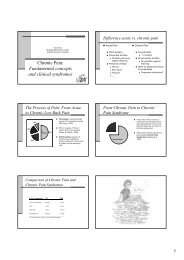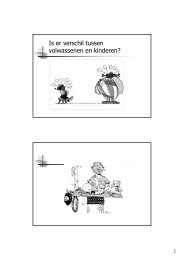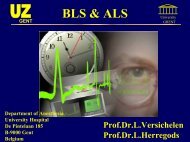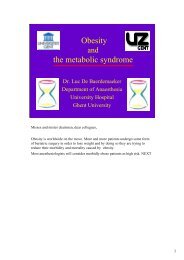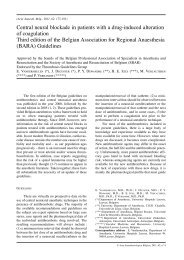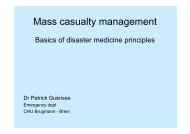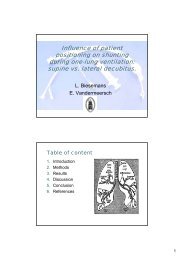Combined spinal epidural analgesia for labor and delivery
Combined spinal epidural analgesia for labor and delivery
Combined spinal epidural analgesia for labor and delivery
You also want an ePaper? Increase the reach of your titles
YUMPU automatically turns print PDFs into web optimized ePapers that Google loves.
(Acta Anaesth. Belg., 2009, 60, 109-122)<br />
<strong>Combined</strong> <strong>spinal</strong> <strong>epidural</strong> <strong>analgesia</strong> <strong>for</strong> <strong>labor</strong> <strong>and</strong> <strong>delivery</strong> : a<br />
balanced view based on experience <strong>and</strong> literature<br />
M. VAN DE VELDE<br />
INTRODUCTION<br />
Almost two decades have passed since French<br />
<strong>and</strong> American trials evaluated the use of <strong>spinal</strong> opioids<br />
during <strong>labor</strong> <strong>and</strong> since European r<strong>and</strong>omized<br />
trials compared conventional <strong>epidural</strong> <strong>analgesia</strong><br />
with combined <strong>spinal</strong> <strong>epidural</strong> (CSE) <strong>analgesia</strong> (19,<br />
35, 50). CSE <strong>analgesia</strong> has gained worldwide<br />
acceptance <strong>and</strong> is becoming increasingly popular as<br />
the method of choice <strong>for</strong> <strong>labor</strong> pain relief (54, 117,<br />
126, 134, 135, 164). Numerous (> 280 trials, per<strong>for</strong>ming<br />
a literature search using CSE, combined<br />
<strong>spinal</strong> <strong>epidural</strong> <strong>analgesia</strong> <strong>and</strong> <strong>labor</strong> as search terms,<br />
were identified) studies compared CSE with conventional<br />
<strong>epidural</strong>, evaluated various intrathecal<br />
drug combinations or reported on side-effects of<br />
CSE.<br />
Obstetric anesthetists are divided when questioned<br />
on the place of CSE in <strong>labor</strong> <strong>analgesia</strong>.<br />
Whilst some authors feel it should be the technique<br />
of choice, others reserve CSE <strong>for</strong> certain indications<br />
(34, 80, 129, 131, 141, 142). Recently, SIMMONS et<br />
al. published a Cochrane review concluding that<br />
CSE offers little benefit as compared to conventional<br />
<strong>epidural</strong> <strong>analgesia</strong> (151). However, the authors of<br />
this meta-analysis did acknowledge that CSE produced<br />
faster <strong>analgesia</strong>, resulted in less need <strong>for</strong> rescue<br />
<strong>analgesia</strong> <strong>and</strong> was associated with less urinary<br />
retention. Apart from a slight increase in the incidence<br />
of pruritus, these beneficial effects were not<br />
associated with more complications. In this authors<br />
opinion the three demonstrated benefits of CSE are<br />
sufficient to promotes it’s use if the side-effect profile<br />
remains unaltered. Furthermore it must be<br />
stressed that this Cochrane review can be criticized.<br />
Firstly, a number of well per<strong>for</strong>med studies were<br />
excluded from analysis because of uncertain reasons.<br />
Inclusion of these well per<strong>for</strong>med studies into<br />
the analysis might have affected the overall conclusions.<br />
Secondly, a number of outcomes were not<br />
considered in the analysis such as one-sided <strong>analgesia</strong>,<br />
<strong>epidural</strong> catheter reliability, anesthetist intervention<br />
rate, local anesthetic consumption <strong>and</strong> the<br />
occurrence of fetal heart rate abnormalities. Finally,<br />
very different types of CSE were used in the various<br />
studies. They were all considered to be a generic<br />
procedure <strong>and</strong> analyzed together.<br />
This manuscript reviews the available literature,<br />
including those trials that were ignored by the<br />
Cochrane review, <strong>and</strong> draws conclusions regarding<br />
the place of CSE in the management of <strong>labor</strong> pain.<br />
This review will evaluate efficacy <strong>and</strong> safety of<br />
CSE <strong>and</strong> make comparisons with conventional<br />
<strong>epidural</strong> <strong>analgesia</strong>, advise on the ideal <strong>spinal</strong> drug<br />
combination <strong>and</strong> give recommendations regarding<br />
maintenance of <strong>epidural</strong> <strong>analgesia</strong> once the <strong>spinal</strong><br />
component wears off.<br />
CHARACTERISTICS OF LABOR PAIN RELIEF : CSE VS CON-<br />
VENTIONAL EPIDURAL<br />
Onset time of <strong>analgesia</strong><br />
Arguably, the most obvious advantage of the<br />
CSE technique is the rapid <strong>and</strong> spectacular onset of<br />
effective <strong>analgesia</strong> with minute concentrations of<br />
local anesthetics with or without adjuvant<br />
drugs (151). Consistently, effective <strong>labor</strong> <strong>analgesia</strong><br />
is accomplished within 4-6 minutes following the<br />
intrathecal injection of drugs (1, 19, 35, 36, 37, 58,<br />
73, 74, 104, 121, 152, 159, 162, 166, 167) (Fig. 1).<br />
Following conventional <strong>epidural</strong> <strong>analgesia</strong>, initial<br />
<strong>analgesia</strong> is usually achieved within 15 to 25 minutes.<br />
Some detractors argue that conventional<br />
M. VAN DE VELDE, M.D., Ph.D.<br />
Department of Anesthesiology, University Hospitals<br />
Gasthuisberg, Katholieke Universiteit Leuven, Leuven,<br />
Belgium.<br />
Correspondence address : Marc Van de Velde, Director<br />
Obstetric Anesthesia <strong>and</strong> Extra Muros Anesthesia,<br />
Department of Anesthesiology, University Hospitals<br />
Gasthuisberg, Herestraat 49, B-3000 Leuven, Belgium.<br />
Tel. : 0032-16 34 42 70. Fax : 0032-16 34 42 45.<br />
E-mail : marc.v<strong>and</strong>evelde@uz.kuleuven.ac.be<br />
© Acta Anæsthesiologica Belgica, 2009, 60, n° 2
110 M. VAN DE VELDE<br />
Fig. 1. — Onset time of <strong>analgesia</strong> following CSE or conventional<br />
<strong>epidural</strong> <strong>analgesia</strong> (minutes). Onset time is consistently<br />
shorter in CSE treated patients.<br />
<strong>epidural</strong> <strong>analgesia</strong> provides equally fast <strong>analgesia</strong><br />
(104).<br />
It is important to note, however, that although<br />
the onset time of <strong>epidural</strong> <strong>analgesia</strong> might be reasonable,<br />
the reported values are means. With<br />
<strong>epidural</strong> <strong>analgesia</strong>, a wide inter-patient variability<br />
exists with respect to onset time of <strong>analgesia</strong>,<br />
depending on parity, stage of <strong>labor</strong> <strong>and</strong> other relevant<br />
obstetrical <strong>and</strong> non-obstetrical factors.<br />
Especially during late <strong>labor</strong>, <strong>analgesia</strong> following an<br />
<strong>epidural</strong> injection is often delayed, <strong>and</strong> only successful<br />
if large doses are administered. With CSE,<br />
onset time is short in all patients irrespective of the<br />
stage of <strong>labor</strong> <strong>and</strong> other factors. The dose of local<br />
anesthetic only needs slight increases when <strong>labor</strong> is<br />
significantly advanced.<br />
Quality of pain relief : VAS scores, satisfaction <strong>and</strong><br />
anesthetist intervention rate<br />
Several trials demonstrated lower VAS scores<br />
<strong>for</strong> <strong>labor</strong> pain with CSE as compared to <strong>epidural</strong><br />
<strong>analgesia</strong> (36, 62, 77, 154). However, other comparative<br />
trials could not demonstrate a difference in<br />
VAS scores <strong>for</strong> pain (69, 104, 132). No trials report<br />
higher VAS scores with CSE. Most likely, especially<br />
during the first 30 to 60 minutes, VAS scores are<br />
lower when patients receive CSE.<br />
Most anesthesiologists would agree that CSE<br />
provides better quality <strong>analgesia</strong> throughout the<br />
course of <strong>labor</strong> (84). Vernis <strong>and</strong> co-workers demonstrated<br />
that less patients reported unilateral <strong>analgesia</strong><br />
whith CSE as compared to conventional <strong>epidural</strong><br />
<strong>analgesia</strong> (167). Interestingly, HESS et al. investigated<br />
the factors associated with breakthrough pain<br />
during neuraxial <strong>labor</strong> <strong>analgesia</strong> <strong>and</strong> found that<br />
patients treated with conventional <strong>epidural</strong> <strong>analgesia</strong><br />
were three times as likely to experience recurrent<br />
breakthrough pain as compared to CSE treated<br />
women (71). However, GOODMAN et al., in a<br />
prospective study, failed to corroborate the latter<br />
study (62). These authors noted that additional topups<br />
to treat breakthrough pain were requested by<br />
similar numbers of patients irrespective of the analgesic<br />
strategy used (62).<br />
The presence of a dural puncture may facilitate<br />
the passage of <strong>epidural</strong>ly administered drugs<br />
during maintenance of <strong>analgesia</strong> to the cerebro<strong>spinal</strong><br />
fluid. Such an effect has been reported, at<br />
least in animals (155). In patients, LEIGHTON et al.<br />
also reported that <strong>epidural</strong> bupivacaine blocked<br />
more dermatomes when administered following an<br />
initial dural puncture as compared to <strong>epidural</strong> bupivacaine<br />
administered without prior dural puncture<br />
(87). LEIGHTON et al. used a 24 <strong>and</strong> 27G <strong>spinal</strong><br />
needle. Cappiello <strong>and</strong> co-workers per<strong>for</strong>med a<br />
study in which the dura was per<strong>for</strong>ated with a 25G<br />
Whitacre needle, without any administration of<br />
<strong>spinal</strong> drugs (22). The control group had no dural<br />
puncture. In both groups, <strong>analgesia</strong> was initiated<br />
with an <strong>epidural</strong> local anesthetic/opioid mixture.<br />
Patients treated with a dural puncture had better<br />
sacral spread, shorter onset of <strong>analgesia</strong> <strong>and</strong> better<br />
quality pain relief. Thomas et al. per<strong>for</strong>med a similar<br />
study using a 27G Whitacre needle <strong>and</strong> could<br />
not find a difference between patients treated with<br />
or without a dural puncture (156). There<strong>for</strong>e, <strong>spinal</strong><br />
needle size may be important.<br />
Many studies report higher patient satisfaction<br />
with CSE (36, 37, 47, 162), while no studies report<br />
on the opposite.<br />
Local anesthetic consumption<br />
Despite similar or improved quality of <strong>analgesia</strong>,<br />
local anesthetic requirements are significantly<br />
reduced with CSE as compared to low dose conventional<br />
<strong>epidural</strong> techniques (36, 37, 77, 162, 167).<br />
Discussion remains whether this is the result of the<br />
omission of the initial <strong>epidural</strong> bolus or whether a<br />
© Acta Anæsthesiologica Belgica, 2009, 60, n° 2
COMBINED SPINAL EPIDURAL ANALGESIA FOR LABOR AND DELIVERY 111<br />
Table 1<br />
Reliability of <strong>epidural</strong> catheters :% of failed <strong>epidural</strong> catheters<br />
not producing adequate <strong>analgesia</strong> <strong>and</strong> resited<br />
CSE<br />
Epidural<br />
NORRIS 2000 (107) 0.2% 1.3%<br />
COMET 2001 (38) 4.0% 6.8%<br />
VAN DE VELDE 2001 (161) 1.49% 3.18%<br />
THOMAS 2005 (156) 9.3% 8.0% *<br />
CAPPIELLO 2008 (22) 3% 13%<br />
LEE 2009 (86) 1% 6%<br />
MIRO 2008 (98) 3.4% 6.2%<br />
* THOMAS et al. reported more catheter replacement when the<br />
<strong>spinal</strong> component failed (22.2%).<br />
Cesarean section when the catheter was placed as<br />
part of a CSE technique <strong>for</strong> <strong>labor</strong> <strong>analgesia</strong> (86).<br />
When using a CSE technique, a perfect midline<br />
approach is required to identify the subarachnoid<br />
space <strong>and</strong>, consequently, more <strong>epidural</strong><br />
catheters are reliably positioned into the <strong>epidural</strong><br />
space (161). THOMAS et al. interestingly noted that,<br />
when no cerebro<strong>spinal</strong> fluid was obtained following<br />
attempted CSE, much more <strong>epidural</strong> catheters<br />
required replacement subsequently, as compared to<br />
those catheters placed when cerebro<strong>spinal</strong> fluid was<br />
noted (156).<br />
Failed <strong>spinal</strong> component<br />
dose sparing effect also persists during <strong>labor</strong>. The<br />
presence of the dural whole <strong>and</strong> the facilitated passage<br />
of <strong>epidural</strong>ly administered local anesthetics<br />
could offer part of the explanation.<br />
Duration of initial <strong>analgesia</strong><br />
Duration of initial <strong>spinal</strong> <strong>analgesia</strong> is usually<br />
similar to the duration of an initial <strong>epidural</strong><br />
bolus (69, 104, 162). Spinal <strong>analgesia</strong> typically<br />
lasts <strong>for</strong> 90-150 minutes, but a wide variety exists,<br />
depending on the administered <strong>spinal</strong> drugs <strong>and</strong> on<br />
pain modulating factors such as parity, stage of<br />
<strong>labor</strong>, speed of <strong>labor</strong>, etc... (19, 27, 43, 49, 73, 95,<br />
116, 118, 150, 168). In ideal circumstances <strong>and</strong><br />
using multi-drug combinations, <strong>spinal</strong> <strong>analgesia</strong><br />
may last <strong>for</strong> more than 4 hours (43, 116). Several<br />
authors continue the search <strong>for</strong> long lasting <strong>spinal</strong><br />
<strong>analgesia</strong>, hoping that single shot <strong>spinal</strong> <strong>analgesia</strong><br />
would ultimately be achieved. Despite extensive<br />
research, disappointingly, no more (<strong>and</strong> often less)<br />
than 50% of patients deliver during the initial <strong>spinal</strong><br />
<strong>analgesia</strong> (168).<br />
Epidural catheter reliability<br />
Following initial <strong>spinal</strong> <strong>analgesia</strong>, bilateral<br />
<strong>analgesia</strong> <strong>and</strong> sensory changes occur, rendering the<br />
testing of the <strong>epidural</strong> catheter difficult. Hence, one<br />
may question about the reliability of the catheter to<br />
achieve bilateral <strong>analgesia</strong> once the <strong>spinal</strong> dose has<br />
worn off. However, several investigators noted that<br />
the reliability of <strong>epidural</strong> catheters following CSE<br />
is similar or better than st<strong>and</strong> alone <strong>epidural</strong><br />
catheters (22, 38, 86, 98, 107, 109, 156, 161)<br />
(Table 1). They showed less need <strong>for</strong> <strong>epidural</strong><br />
catheter replacement <strong>and</strong> less unilateral <strong>analgesia</strong><br />
requiring catheter manipulation. LEE et al. reported<br />
less catheter failure at the time of topping up <strong>for</strong><br />
Failure to identify the <strong>spinal</strong> space <strong>and</strong><br />
produce good <strong>spinal</strong> <strong>analgesia</strong> is reported in 0-18%<br />
of patients (156). As with every technique, failure<br />
may occur, but, in these instances, the <strong>epidural</strong><br />
catheter can still be used to provide <strong>analgesia</strong>.<br />
Failure of the <strong>spinal</strong> component indicates that the<br />
<strong>epidural</strong> needle is not perfectly situated on the midline<br />
<strong>and</strong> is a risk factor <strong>for</strong> subsequent <strong>epidural</strong><br />
catheter failure (156). In this case, re-positioning of<br />
the <strong>epidural</strong> needle is advocated by this author.<br />
COMPLICATIONS OF LABOR ANALGESIA : CSE ANALGESIA<br />
VS CONVENTIONAL EPIDURAL ANALGESIA<br />
Pruritus<br />
This is the most common side effect of<br />
intrathecal opioids, occurring in almost all patients,<br />
if directly questioned (36, 98, 162, 167). In the most<br />
recent Cochrane review, pruritus was reported more<br />
frequently following CSE <strong>and</strong> was reported to be<br />
the only complication occurring more frequently<br />
than with conventional <strong>epidural</strong> <strong>analgesia</strong> (152). It<br />
usually develops shortly after <strong>analgesia</strong>. It is mild<br />
<strong>and</strong> hardly ever requires antipruritic therapy.<br />
Prophylactic ondansetron is ineffective to reduce<br />
the incidence or severity of opioid induced pruritus<br />
(169). Opioid induced itching is dose-dependent<br />
<strong>and</strong> can be modulated by other adjuvant drugs such<br />
as epinephrine (12, 19). Since patients hardly ever<br />
require therapy <strong>and</strong> seldom report pruritus as a reason<br />
<strong>for</strong> dissatisfaction, pruritus is not a reason to<br />
refrain the use of CSE <strong>and</strong> intrathecal opioids.<br />
Nausea<br />
Nausea <strong>and</strong> vomiting are very rare com -<br />
plications during CSE <strong>and</strong> conventional <strong>epidural</strong><br />
© Acta Anæsthesiologica Belgica, 2009, 60, n° 2
112 M. VAN DE VELDE<br />
<strong>analgesia</strong>. No differences in the incidence of nausea<br />
have between reported when comparing the two<br />
techniques, except in the retrospective trial by MIRO<br />
et al. who reported more nausea <strong>and</strong> vomiting in<br />
patients treated with <strong>epidural</strong> <strong>analgesia</strong> (98). We<br />
must remember that nausea is a part of the birth<br />
process especially during induced labour.<br />
Hypotension<br />
As with any neuraxial technique, hypotension<br />
can occur following labour <strong>analgesia</strong>. Both CSE <strong>and</strong><br />
conventional <strong>epidural</strong> <strong>analgesia</strong> have been associated<br />
with usually mild hypotension, which is easily<br />
treated (110). Both ROFAEL et al. <strong>and</strong> VAN DE VELDE<br />
et al. reported a high incidence of hypotension following<br />
CSE using a combination of local anesthetics<br />
<strong>and</strong> opioids (139, 162). Hypotension following<br />
the <strong>spinal</strong> injection is transient <strong>and</strong> occurs within the<br />
first 30 minutes following initiation of <strong>analgesia</strong><br />
(99, 149, 167). In that respect, it is important to<br />
avoid the supine position. We always keep our<br />
patients in the completely left lateral decubitus position<br />
to avoid any effect of aortacaval compression.<br />
Hypotension occurs due to sympathetic blockade,<br />
alleviation of pain <strong>and</strong> perhaps because incorrect<br />
baseline values are used as reference (13).<br />
Indeed, if the blood pressure that immediately precedes<br />
the block is considered as the baseline value,<br />
the diagnosis of hypotension may be made inappropriately.<br />
Pain <strong>and</strong> discom<strong>for</strong>t induce hypertension<br />
<strong>and</strong> cloud the issue. There<strong>for</strong>e, various authors recommend<br />
the use of the prenatal blood pressure as<br />
the baseline value.<br />
Although opioids do not produce sympatholysis,<br />
hypotension is observed with pure intrathecal<br />
opioid <strong>analgesia</strong> (26, 91, 102, 138). When local<br />
anaesthetics are combined, hypotension seems to be<br />
more pronounced, but is usually easily treated<br />
(102). Intrathecal clonidine, however, is often<br />
associated with severe hypotension <strong>and</strong> this author<br />
can not recommend it’s routine use, based on his<br />
personal experience. Hypotension can be severe<br />
<strong>and</strong> is often protracted, requiring prolonged supportive<br />
vasopressor therapy (27, 125).<br />
Respiratory depression<br />
Respiratory depression is a recognized complication<br />
of intrathecal opioids during <strong>labor</strong>, probably<br />
as a result of rostral spread. Several case reports<br />
have demonstrated that lipid soluble opioids may<br />
induce this potentially life threatening complication<br />
(10, 52, 63, 67, 73, 76, 90, 120, 124). In some,<br />
but not all cases, respiratory arrest can occur in relatively<br />
short stature women who received parenteral<br />
or <strong>epidural</strong> opioids prior to the <strong>spinal</strong> injection.<br />
Fortunately, respiratory depression typically occurs<br />
within the first 30 minutes <strong>and</strong> is easily reversed<br />
using naloxone. However, chest compressions <strong>and</strong><br />
resuscitation may be required (124). FERROUZ et al.<br />
per<strong>for</strong>med a retrospective chart analysis <strong>and</strong> reported<br />
1 respiratory arrest in over 5000 CSE per<strong>for</strong>med<br />
with 10 µg <strong>spinal</strong> sufentanil (52). As this complication<br />
is rare, most authors advocate vigilance <strong>and</strong><br />
advise to use lower doses of intrathecal opioids than<br />
those initially used on empirical grounds (5).<br />
Other complications related to excessive<br />
rostral spread of opioids <strong>and</strong> local anaesthetics have<br />
been described <strong>and</strong> include : aphonia, aphagia,<br />
dysphagia, altered levels of consciousness, high<br />
sensory block, transient swallowing difficulties,<br />
etc... (32, 41, 53, 65, 83, 145). Sudden hypoglyce -<br />
mia has also been described (40, 78).<br />
Central nervous system infections<br />
Some authorities claim that the risk of central<br />
nervous system infections is increased secondary to<br />
the breach of the dura (16). However, Camann <strong>and</strong><br />
Birnbach both agree that, at the moment, there is no<br />
scientific evidence indicating that CSE <strong>analgesia</strong> is<br />
associated with more infectious problems than<br />
<strong>epidural</strong> <strong>analgesia</strong> (13, 20). Indeed, several case<br />
reports of meningitis or <strong>epidural</strong> abscess have been<br />
reported following CSE anesthesia in obstetric<br />
patients (7, 15, 25, 66, 128, 167), but also after<br />
simple <strong>spinal</strong> anesthesia <strong>and</strong> conventional <strong>epidural</strong><br />
techniques (11, 45, 103, 136). Despite these<br />
occasional case reports, CNS infections remain<br />
extremely rare, irrespective of the neuraxial technique<br />
used. Six publications evaluate the risk of<br />
infections following neuraxial anesthesia in obstetric<br />
patients (5, 39, 68, 119, 123, 146). In over<br />
900.000 patients, only 2 cases of <strong>epidural</strong> abscess<br />
<strong>and</strong> 3 cases of meningitis were reported. Most<br />
authors, however, agree that strict aseptic techniques<br />
are of vital importance to prevent serious infections.<br />
Neurologic complications<br />
As with any regional technique, the potential<br />
<strong>for</strong> nerve damage is present. Several case reports in<br />
pregnant women of damage to the conus medullaris<br />
have been reported when using CSE (137).<br />
Especially with CSE, it is imperative to per<strong>for</strong>m the<br />
block as low as possible, as far as the conus<br />
medullaris might extend below the L2 vertebral<br />
© Acta Anæsthesiologica Belgica, 2009, 60, n° 2
COMBINED SPINAL EPIDURAL ANALGESIA FOR LABOR AND DELIVERY 113<br />
body in up to 5% of parturients (24). It has been<br />
clearly demonstrated, using radiography <strong>and</strong> ultrasound,<br />
that most anesthetists, using anatomical<br />
l<strong>and</strong>marks, are 1 to 4 interspaces away from where<br />
they think to be (24, 170). Identification of the correct<br />
interspace is there<strong>for</strong>e of prime importance.<br />
Ultrasound may be useful in that respect, especially<br />
in obese patients (24).<br />
Post dural puncture headache (PDPH)<br />
Since CSE involves a dural puncture, there is a<br />
theoretical risk of postdural puncture headache<br />
(PDPH). This is a devastating complication in an<br />
otherwise healthy mother, keen on taking care <strong>for</strong><br />
her newborn child. However, the use of small-gauge<br />
atraumatic <strong>spinal</strong> needles (26-29 G) has dramatically<br />
decreased the problem. From the available literature,<br />
it seems that PDPH occurs in no more than 1%<br />
of patients. Furthermore, the incidence is not<br />
increased as compared to conventional <strong>epidural</strong><br />
<strong>analgesia</strong> (13, 36, 38, 47, 84, 91, 98, 100, 109, 110,<br />
160, 161, 167). NORRIS et al. reported that unintended<br />
dural puncture with the <strong>epidural</strong> needle occurs<br />
much more frequently when using conventional<br />
<strong>epidural</strong> <strong>analgesia</strong> as compared to CSE (110)<br />
Rarely, the <strong>spinal</strong> needle itself is responsible <strong>for</strong><br />
PDPH. Usually, a dural tap with either the Tuohy<br />
needle or the <strong>epidural</strong> catheter causes postural<br />
headache. It is also worthwhile to mention several<br />
reports advising to insert the <strong>epidural</strong> catheter in the<br />
subarachnoid space following an accidental dural<br />
tap. The incidence of PDPH <strong>and</strong> bloodpatching<br />
seems to be reduced when the <strong>epidural</strong> catheter is<br />
threaded intrathecally (30, 111, 143, 148, 160).<br />
Of interest is that air should be replaced by<br />
saline in the loss of resistance technique, as air<br />
might cause more PDPH, increase its severity <strong>and</strong><br />
induce other problems with the <strong>epidural</strong> block, such<br />
as recurrent breakthrough pain (3, 88).<br />
Motor block<br />
For many years, strategies to reduce the incidence<br />
<strong>and</strong> severity of motor block, associated with<br />
<strong>epidural</strong> <strong>analgesia</strong>, have been designed. Lower concentrations<br />
of local anesthetic solutions, the addition<br />
of opioids <strong>and</strong> other adjuvant drugs, the introduction<br />
of patient controlled <strong>epidural</strong> <strong>analgesia</strong> <strong>and</strong><br />
the use of newer local anesthetic agents have been<br />
instrumental in reducing problematic motor block.<br />
Low dose <strong>epidural</strong>s are successfully used to allow<br />
<strong>labor</strong>ing women to maintain mobility whilst being<br />
completely pain free (37, 100). With CSE, it is easier<br />
to provide effective <strong>analgesia</strong> with no or very<br />
minute doses of local anesthetics. As already<br />
described, CSE decreases the total local anesthetic<br />
consumption (36, 37, 162) <strong>and</strong> decreases the occurrence<br />
of motor block when compared to a st<strong>and</strong>ard<br />
<strong>epidural</strong> technique (36, 37, 100, 162).<br />
Some authors have questioned about the safety<br />
of walking during <strong>labor</strong> <strong>and</strong> neuraxial <strong>analgesia</strong>.<br />
However, several authors demonstrated that, with<br />
CSE, motor function <strong>and</strong> balance remains intact,<br />
whilst low dose <strong>epidural</strong>s induce clinically<br />
detectable dorsal column deficits (17, 44, 127).<br />
Ambulation became common practice <strong>and</strong> can be<br />
advised, provided that adequate precautions, written<br />
protocols <strong>and</strong> testing of motor function following<br />
initiation of <strong>analgesia</strong> are undertaken. Motor<br />
function testing is straight<strong>for</strong>ward <strong>and</strong> includes the<br />
ability to per<strong>for</strong>m a deep unassisted knee bend <strong>and</strong><br />
to per<strong>for</strong>m a straight leg lift <strong>for</strong> 30 seconds with the<br />
eyes closed. It remains unclear how <strong>epidural</strong> maintenance<br />
of <strong>analgesia</strong> affects postural stability <strong>and</strong><br />
motor function (44).<br />
Caution is required when using <strong>epidural</strong> test<br />
doses following insertion of an <strong>epidural</strong> catheter,<br />
since test doses can significantly impair motor<br />
strength (31). Controversy also exists on the effects<br />
of <strong>spinal</strong>ly administered epinephrine (64, 166) on<br />
the motor block. Whilst minute doses do not impair<br />
motor function, larger doses have a significant<br />
impact. A small dose of intrathecal epinephrine<br />
conveys clinical benefits in terms of prolonged<br />
<strong>spinal</strong> <strong>analgesia</strong> (64, 166).<br />
Although reduced motor block <strong>and</strong> ambulation<br />
during neuraxial <strong>analgesia</strong> are certainly feasible,<br />
controversy concerning the benefits of ambulation<br />
remains (17, 51). Several trials demonstrated that<br />
ambulation during <strong>labor</strong> does not affect the outcome<br />
of <strong>labor</strong> (100), whilst others did note a beneficial<br />
effect. In patients without <strong>epidural</strong> <strong>analgesia</strong>,<br />
ambulation halved the operative <strong>delivery</strong> rate (4).<br />
Ambulation also reduced the length of the second<br />
stage of <strong>labor</strong> (60). In the COMET trial, mobile<br />
techniques of <strong>labor</strong> <strong>analgesia</strong> were associated with<br />
an improved <strong>labor</strong> outcome (37, 38). Despite this<br />
controversy, those women actually using ambulation<br />
during <strong>labor</strong> prefer ambulation, as it increases<br />
their feelings of self control. It was also noted that<br />
<strong>epidural</strong> top-ups administered during ambulation<br />
induced less hypotension than top-ups administered<br />
in the supine position (8).<br />
Progress <strong>and</strong> outcome of <strong>labor</strong><br />
Epidural <strong>analgesia</strong> has been implicated in<br />
prolonged <strong>labor</strong>s, in increased instrumental <strong>delivery</strong><br />
© Acta Anæsthesiologica Belgica, 2009, 60, n° 2
114 M. VAN DE VELDE<br />
rate <strong>and</strong> in increased Cesarean section rate.<br />
Extensive research has now led to unanimous consensus<br />
that <strong>epidural</strong> <strong>analgesia</strong> does not produce<br />
more instrumental vaginal <strong>and</strong> operative deliveries.<br />
However, <strong>epidural</strong> <strong>analgesia</strong> prolongs the duration<br />
of the first stage of <strong>labor</strong> <strong>and</strong> increases the need <strong>for</strong><br />
exogenous oxytocin.<br />
TSEN et al. demonstrated in a prospective,<br />
r<strong>and</strong>omized trial that CSE is associated with an<br />
increased cervical dilation rate. Patients r<strong>and</strong>omized<br />
to CSE <strong>analgesia</strong> experienced a doubling of the<br />
mean cervical dilation rate <strong>and</strong> a reduced duration<br />
of the first stage of <strong>labor</strong> as compared to <strong>epidural</strong><br />
<strong>analgesia</strong> (157). Several mechanisms have been<br />
proposed to explain these observations. First,<br />
CSE rapidly reduces epinephrine plasma levels.<br />
Since epinephrine is tocolytic (147), CSE quickly<br />
enhances uterine activity. Since <strong>analgesia</strong> <strong>and</strong> plasma<br />
epinephrine lowering occur much more rapidly<br />
than with conventional <strong>epidural</strong> <strong>analgesia</strong>, progression<br />
of <strong>labor</strong> could be enhanced. Second, since high<br />
doses of local anesthetics are avoided with CSE, the<br />
in vitro <strong>and</strong> in vivo observations that bupivacaine<br />
impairs uterine activity are also avoided (74, 171).<br />
Disappointingly, several r<strong>and</strong>omized trials comparing<br />
CSE with conventional <strong>epidural</strong> <strong>analgesia</strong> could<br />
not demonstrate a difference in <strong>labor</strong> duration (37,<br />
109, 159, 162).<br />
As compared with low dose <strong>epidural</strong> strategies,<br />
CSE was not associated with an increased<br />
spontaneous vaginal <strong>delivery</strong> rate in most trials (36,<br />
37, 47, 109, 132, 159, 162). Only one trial reported<br />
less instrumental vaginal deliveries with CSE than<br />
with <strong>epidural</strong> <strong>analgesia</strong> (100).<br />
Fetal heart rate changes<br />
Abnormal fetal heart rate recordings <strong>and</strong> fetal<br />
bradycardia are worrisome side effects that may follow<br />
any type of effective <strong>labor</strong> <strong>analgesia</strong>. WONG et<br />
al. reported more abnormal cardiotocographic readings<br />
following CSE as compared to systemic <strong>analgesia</strong><br />
(173). Some authors reported that this complication<br />
could be more common following intrathecal<br />
opioids than following conventional <strong>epidural</strong> <strong>analgesia</strong><br />
(28, 29, 72, 79). CLARKE et al. were the first to<br />
describe in detail the association between intrathecal<br />
opioids, uterine hyperactivity <strong>and</strong> fetal bradycardia<br />
in the absence of maternal hypotension (28).<br />
Since then, several non-r<strong>and</strong>omized trials have evaluated<br />
the incidence of fetal heart rate changes following<br />
either intrathecal opioids or conventional<br />
<strong>epidural</strong> <strong>analgesia</strong> (106, 122, 161, 163). NIELSEN et<br />
al. <strong>and</strong> EBERLE et al. did not observe an increased<br />
Table 2<br />
Incidence (%) of fetal heart rate abnormalities following CSE<br />
or conventional <strong>epidural</strong> <strong>analgesia</strong> as reported using a nonr<strong>and</strong>omised<br />
study design.<br />
CSE<br />
Conventional <strong>epidural</strong><br />
NIELSEN 1996 (106) 15.4% 18.8%<br />
EBERLE 1998 (48) 3.9% 3.9%<br />
KAHN 1998 (75) 5.6% 2.5%<br />
PALMER 1999 (122) 12% 6%<br />
VAN DE VELDE 2001 (163) 11.4% 5.9%<br />
incidence of fetal heart rate abnormalities, whilst all<br />
other non-r<strong>and</strong>omised reports noted at least a doubling<br />
of the incidence of worrisome fetal heart rate<br />
changes (5) (Table 2).<br />
MARDIROSSOF et al. per<strong>for</strong>med a meta analysis<br />
of several prospective trials comparing intrathecal<br />
opioid <strong>analgesia</strong> with non-intrathecal opioid <strong>analgesia</strong>,<br />
with respect to fetal bradycardia (93). These<br />
authors concluded that intrathecal opioids were<br />
associated with significantly more fetal heart rate<br />
abnormalities. Vercauteren suggested that the incidence<br />
of fetal bradycardia depended on the dose of<br />
the intrathecal opioid (165). VAN DE VELDE et al.<br />
per<strong>for</strong>med a prospective, r<strong>and</strong>omized trial that was<br />
specifically designed to evaluate the effects of<br />
intrathecal opioids on the incidence of worrisome<br />
fetal heart rate changes (162). These authors concluded<br />
that high doses of intrathecal opioids<br />
increased the incidence of fetal heart rate abnormalities<br />
despite a reduced incidence of hypotension.<br />
Similar results were published by NICOLET et<br />
al. (105). These authors also indicated that older<br />
age <strong>and</strong> higher VAS scores prior to <strong>analgesia</strong> were<br />
risk factors of fetal heart rate abnormalities after<br />
CSE. Gaiser suggested that the risk of fetal heart<br />
rate abnormalities is increased when the fetal head<br />
is not engaged or when decelerations are already<br />
present prior to the initiation of <strong>analgesia</strong> (56).<br />
The presumed mechanism of opioid induced<br />
non-reassuring fetal heart rate tracings is uterine<br />
hyperactivity caused by a rapid onset <strong>analgesia</strong> <strong>and</strong>,<br />
as a result, a rapid decrease in maternal circulating<br />
cathecholamines. Based on <strong>labor</strong>atory investigations<br />
by SEGAL et al., increased myometrical tone<br />
<strong>and</strong> increased uterine vascular resistance may be<br />
caused by the decrease of epinephrine levels in the<br />
continuing presence of high norepinephrine levels<br />
when CSE <strong>analgesia</strong> is per<strong>for</strong>med (26, 147). ABRAO<br />
et al. recently measured uterine tone using an<br />
intrauterine pressure catheter following either CSE<br />
or conventional <strong>epidural</strong> <strong>analgesia</strong> (2). Fetal heart<br />
rate changes <strong>and</strong> uterine hypertonus occurred more<br />
© Acta Anæsthesiologica Belgica, 2009, 60, n° 2
COMBINED SPINAL EPIDURAL ANALGESIA FOR LABOR AND DELIVERY 115<br />
frequently following CSE. Analgesia was initiated<br />
rather late during <strong>labor</strong> <strong>and</strong>, un<strong>for</strong>tunately, these<br />
authors only measured intrauterine tone <strong>and</strong> fetal<br />
heart rate <strong>for</strong> 15 minutes after the initiation of <strong>analgesia</strong>.<br />
There<strong>for</strong>e, some changes associated with<br />
<strong>epidural</strong> <strong>analgesia</strong> might have been missed. They<br />
also demonstrated that the faster <strong>and</strong> the more pronounced<br />
the <strong>analgesia</strong>, the higher the probability of<br />
abnormal cardiotocographic readings. Of course,<br />
this effect is strengthened by the simultaneous<br />
occurrence of maternal hypotension in some<br />
patients.<br />
Further study of the involved mechanism<br />
seems there<strong>for</strong>e to be required. Other mechanisms,<br />
such as direct central effects of sufentanil, are possibly<br />
involved. We can only speculate about alternative<br />
pathophysiological mechanisms. Maternal rostral<br />
spread of <strong>spinal</strong> opioids may centrally affect the<br />
release of oxytocin <strong>and</strong> subsequently induce uterine<br />
hyperactivity. It is known that intravenous opioids<br />
have central effects <strong>and</strong> alter the release of various<br />
central peptides, including oxytocin <strong>and</strong> vasopressin<br />
(140). In a recent interesting paper, STOCCHE<br />
et al. studied the release of oxytocin in women during<br />
the first stage <strong>labor</strong> <strong>and</strong> undergoing regional<br />
<strong>analgesia</strong> (153). They compared conventional<br />
<strong>epidural</strong> <strong>analgesia</strong> using plain bupivacaine 0.25%<br />
with intrathecal sufentanil 10 µg <strong>and</strong> measured<br />
maternal plasma oxytocin levels at 15, 30, 60 <strong>and</strong><br />
90 minutes after induction of <strong>analgesia</strong>. Intrathecal<br />
sufentanil decreased the plasma concentration of<br />
oxytocin. These results are in contradiction with the<br />
hypothesis that <strong>spinal</strong> opioids may induce uterine<br />
hyperactivity by modulating central oxytocin<br />
release. However, the authors themselves admit<br />
they only infrequently sampled blood. As oxytocin<br />
release typically occurs in spurts, has an extremely<br />
short plasma half-life <strong>and</strong> as the authors only per<strong>for</strong>med<br />
their first sampling after 15 minutes, they<br />
may have missed an initial increase in oxytocin<br />
release followed by the observed decrease in plasma<br />
oxytocin. More work is there<strong>for</strong>e required to<br />
elucidate the mechanism responsible <strong>for</strong> uterine<br />
hyperactivity <strong>and</strong> fetal bradycardia occurring after<br />
intrathecal opioids.<br />
It is important to note that neonatal <strong>and</strong> obstetric<br />
outcome is not affected by the use of intrathecal<br />
opioids. CARVALHO et al. failed to demonstrate any<br />
changes in fetal oxygen saturation following CSE<br />
<strong>analgesia</strong> (23). In none of the reports, emergent<br />
C-sections had to be per<strong>for</strong>med as a result of<br />
sufentanil-induced non-reassuring fetal heart rate<br />
tracings (2, 48, 75, 93, 106, 122, 162, 163, 166). In<br />
addition, neonatal outcome, as assessed by Apgar<br />
scores, umbilical artery pH <strong>and</strong> admittance to the<br />
neonatal intensive care, was unaffected by the technique<br />
used. Albright <strong>and</strong> Forster per<strong>for</strong>med an institutional<br />
retrospective survey involving 2500 patient<br />
records <strong>and</strong> observed no increase in emergency<br />
Cesarean deliveries associated to the use of<br />
intrathecal opioids (6). Only GAMBLING et al. contradicted<br />
this <strong>and</strong> reported an increased C-section<br />
rate due to more non-reassuring fetal heart rate<br />
abnormalities (57). However, also in their study,<br />
neonatal outcome was good <strong>and</strong> not different from<br />
the <strong>epidural</strong> group.<br />
TESTING THE EPIDURAL CATHETER FOLLOWING CSE<br />
Since <strong>epidural</strong> catheters can inadvertently be<br />
misplaced in either the cerebro<strong>spinal</strong> fluid or in an<br />
<strong>epidural</strong> vein, anesthetists have been using test<br />
doses to verify the correct position of the catheter.<br />
Un<strong>for</strong>tunately, test doses are neither sensitive nor<br />
specific (33, 108). Furthermore, epinephrine containing<br />
test doses can induce motor impairment <strong>and</strong><br />
thus complicate ambulation during <strong>labor</strong> (31).<br />
Some authors also suggested that an epinephrine<br />
containing test dose has potential adverse effects on<br />
uteroplacental perfusion (92). As a result, several<br />
authors suggested to ab<strong>and</strong>on routine testing of the<br />
<strong>epidural</strong> catheter, since adequate <strong>analgesia</strong> confirms<br />
the correct position of the catheter without prior<br />
testing (14).<br />
With CSE, <strong>analgesia</strong> occurs rapidly <strong>and</strong> testing<br />
the functionality of the <strong>epidural</strong> catheter is not<br />
possible until the initial <strong>spinal</strong> dose wears off.<br />
Many authors consider the fact that the reliability of<br />
the <strong>epidural</strong> catheter is uncertain during this period<br />
as a major disadvantage. Their concern is related to<br />
the possibility that the catheter may be dysfunctional<br />
when an emergency cesarean section is required.<br />
Especially in high risk pregnancies, this is considered<br />
a major drawback. However, it is important to<br />
note that, even with a well tested <strong>epidural</strong> catheter,<br />
we can never be absolutely sure that, several hours<br />
later, the catheter remains correctly positioned.<br />
Even with conventional <strong>epidural</strong> catheters, fractioned<br />
dosing or a de novo test dose are required<br />
when the catheter is used <strong>for</strong> the injection of high<br />
doses of local anesthetics.<br />
A second concern involves the fact that some<br />
authors do not want to initiate <strong>epidural</strong> <strong>analgesia</strong><br />
immediately after the <strong>spinal</strong> dose. Only when the<br />
<strong>epidural</strong> catheter is <strong>for</strong>mally tested, once the <strong>spinal</strong><br />
dose has worn off, the catheter is used throughout<br />
<strong>labor</strong>. As a result, most patients will experience<br />
© Acta Anæsthesiologica Belgica, 2009, 60, n° 2
116 M. VAN DE VELDE<br />
breakthrough pain. However, several authors initiate<br />
an <strong>epidural</strong> infusion immediately after the initial<br />
<strong>spinal</strong> dose (55). With low volume, low dose techniques,<br />
the risk of total <strong>spinal</strong> anesthesia or toxic<br />
side effects is minimal. These doses cannot produce<br />
systemic toxicity or total <strong>spinal</strong> anesthesia even<br />
when direct intravascular or intrathecal injection<br />
occurs. However, if a continuous <strong>epidural</strong> infusion<br />
or patient controlled <strong>epidural</strong> <strong>analgesia</strong> does not<br />
produce adequate <strong>analgesia</strong>, one must consider an<br />
intravascular position of the catheter.<br />
INTRATHECAL DRUG COMBINATIONS<br />
Local anesthetics<br />
Currently, the most frequently used local anesthetic<br />
agent <strong>for</strong> intrathecal <strong>labor</strong> <strong>analgesia</strong> is bupivacaine,<br />
usually in combination with opioids.<br />
Levobupivacaine <strong>and</strong> ropivacaine have also been<br />
used successfully. LIM et al. compared 2.5 mg bupivacaine<br />
with 2.5 mg ropivacaine <strong>and</strong> 2.5 mg levobupivacaine<br />
(89). Bupivacaine produced the<br />
longest <strong>analgesia</strong> but the highest incidence of motor<br />
block. These results were not confirmed by SAH et<br />
al. who did not find a difference between levobupivacaine<br />
<strong>and</strong> bupivacaine(144). Camorcia <strong>and</strong> coworkers<br />
described the minimum local analgesic<br />
doses of all three local anesthetics <strong>and</strong> suggested a<br />
potency hierarchy of <strong>spinal</strong> bupivacaine > levobupivacaine<br />
> ropivacaine (21). WHITTY et al. described<br />
the ED95 of <strong>spinal</strong> bupivacaine combined with fentanyl<br />
(170). VAN DE VELDE et al. were the first to<br />
construct the full dose response relationship of<br />
<strong>spinal</strong> ropivacaine, levobupivacaine <strong>and</strong> bupivacaine<br />
combined with opioids <strong>for</strong> <strong>labor</strong> <strong>analgesia</strong>.<br />
Contrary to CAMORCIA et al., these investigators<br />
noted that bupivacaine was significantly more<br />
potent then both other local anesthetics <strong>and</strong> that<br />
ropivacaine <strong>and</strong> levobupivacaine were of similar<br />
potency (158).<br />
Opioids<br />
Plain intrathecal opioids are efficient at producing<br />
labour <strong>analgesia</strong>. PALMER et al. established<br />
that 25 µg fentanyl was the optimal intrathecal<br />
dose (121). Increasing the dose above 25 µg did not<br />
improve the duration or quality of <strong>analgesia</strong>, but<br />
increased the incidence of side effects. For sufentanil,<br />
an ED 95 of 8.9 µg was established (70).<br />
However, certainly in Europe, most anaesthesiologist<br />
prefer the intrathecal combination of local<br />
anaesthetics <strong>and</strong> opioids. Adding opioids to the<br />
<strong>spinal</strong> mixture reduces the ED 50 of the local anaesthetic<br />
agent <strong>and</strong> dose-dependently prolongs the<br />
duration of the initial <strong>spinal</strong> <strong>analgesia</strong> (154).<br />
There<strong>for</strong>e, most authors recommend a local anesthetic<br />
/ opioid combination in this indication. WONG<br />
et al. showed that 15 µg fentanyl added to the local<br />
anesthetic/opioid mixture was the optimal dose in<br />
terms of efficacy <strong>and</strong> side-effects (172).<br />
Patients may react very differently to intra -<br />
thecal opioids. LANDAU et al. demonstrated that<br />
mu-opioid receptor genetic variants influence the<br />
dose required to produce effective <strong>analgesia</strong> (85)<br />
(already described above). Respiratory depression<br />
following intrathecal opioids has been described.<br />
This occurred usually in small patients receiving<br />
high doses of opioids following initial parenteral<br />
opioid <strong>analgesia</strong>. Respiratory depression occurred<br />
within 30 minutes from injection. Vigilance following<br />
the intrathecal injection of opioids is there<strong>for</strong>e<br />
required. During labour <strong>analgesia</strong>, intrathecal opioids<br />
have been associated with new onset foetal<br />
heart rate changes (28, 162). Usually these changes<br />
were related to uterine hyperactivity <strong>and</strong> not maternal<br />
hypotension. Several authors postulated that an<br />
imbalance between maternal cathecholamines<br />
following rapid <strong>spinal</strong> <strong>analgesia</strong> produces uterine<br />
hypertonicity. It remains unclear why this only<br />
occurs following high dose intrathecal opioids <strong>and</strong><br />
not following the combination of lower doses of<br />
opioids <strong>and</strong> local anaesthetics (162).<br />
Clonidine<br />
CHIARI et al. studied the use of pure <strong>spinal</strong> clonidine<br />
<strong>for</strong> labour <strong>analgesia</strong> (27). This seems not feasible<br />
since doses producing adequate <strong>analgesia</strong> also<br />
induce unacceptable side effects such as hypotension.<br />
Adding lower doses of clonidine (15-45 µg) to<br />
<strong>spinal</strong> analgesics does improve the duration <strong>and</strong><br />
quality of the initial <strong>spinal</strong> <strong>analgesia</strong> (9, 95, 96,<br />
118). However, especially when clonidine is combined<br />
with local anaesthetic agents, significant <strong>and</strong><br />
prolonged hypotension is likely to occur (9, 96,<br />
118, 125).<br />
Epinephrine<br />
Epidurally administered epinephrine significantly<br />
reduces the MLAC of bupivacaine in labouring<br />
patients <strong>and</strong> improves the quality of <strong>analgesia</strong><br />
(130). Also <strong>for</strong> <strong>spinal</strong> use, epinephrine, combined<br />
with local anaesthetics <strong>and</strong> opioids, has been<br />
evaluated in a wide range of doses from 2.25-<br />
© Acta Anæsthesiologica Belgica, 2009, 60, n° 2
COMBINED SPINAL EPIDURAL ANALGESIA FOR LABOR AND DELIVERY 117<br />
100 µg. Duration of intrathecal <strong>analgesia</strong> was consistently<br />
prolonged (58, 64).<br />
Un<strong>for</strong>tunately, epinephrine also induces an<br />
increased incidence of maternal motor deficit, especially<br />
when administered <strong>epidural</strong>ly or intrathecally<br />
(31, 61). Vercauteren, however, reported that minute<br />
doses (2.25 µg) of <strong>spinal</strong> epinephrine were not associated<br />
with more motor block (166). This was confirmed<br />
by Gurbet <strong>and</strong> co-workers (64). Epidural<br />
epinephrine might also prolong labour duration<br />
through b-agonist effects, especially when higher<br />
doses are infused in the <strong>epidural</strong> space (46, 112,<br />
115). Furthermore, adding epinephrine to pharmacist<br />
pre-prepared solutions complicates storage <strong>and</strong><br />
significantly increases the price of h<strong>and</strong>ling <strong>and</strong><br />
preparation. Thus, this author has ab<strong>and</strong>oned the<br />
addition of epinephrine to the local anaesthetic<br />
solution used <strong>for</strong> <strong>spinal</strong> <strong>and</strong> <strong>epidural</strong> administration.<br />
Neostigmine<br />
NELSON et al. investigated the analgesic potential<br />
<strong>and</strong> side effect profile of 5, 10, 20 µg intrathecal<br />
neostigmine alone (101). From this first phase<br />
study, these investigators chose 10 µg as the optimal<br />
dose to be added to intrathecal sufentanil <strong>and</strong> determined<br />
the ED 50 of <strong>spinal</strong> sufentanil with <strong>and</strong> without<br />
neostigmine. Neostigmine successfully reduced<br />
the ED 50 of <strong>spinal</strong> sufentanil. In a further step, they<br />
compared twice the ED 50 of <strong>spinal</strong> sufentanil with<br />
neostigmine to twice the ED 50 of plain <strong>spinal</strong> sufentanil.<br />
A synergistic effect on the duration of neostigmine-induced<br />
<strong>analgesia</strong> was observed. D’ANGELO et<br />
al., however, reported no increase in analgesic duration<br />
with neostigmine as a part of a multi-drug combination<br />
(local anaesthetic, opioid, clonidine <strong>and</strong><br />
neostigmine) (42). Furthermore, several authors<br />
reported a very high incidence of severe nausea <strong>and</strong><br />
vomiting (116).<br />
Other drugs : magnesium <strong>and</strong> adenosine<br />
Both adenosine <strong>and</strong> magnesium have been<br />
added to intrathecal opioids to relieve labour<br />
pain (18, 133). No significant advantages of adding<br />
adenosine to the analgesic mixture were observed.<br />
Magnesium prolonged intrathecal fentanyl <strong>analgesia</strong>.<br />
MAINTENANCE OF EPIDURAL ANALGESIA FOLLOWING THE<br />
INITIAL SPINAL DOSE<br />
OKUTOMI et al. studied the optimal moment to<br />
initiate a continuous <strong>epidural</strong> infusion following the<br />
initial <strong>spinal</strong> dose (114). These authors suggested to<br />
start the infusion early, within 30 minutes of the<br />
<strong>spinal</strong> dose, to avoid breakthrough pain. MISSANT et<br />
al. studied patient-controlled <strong>epidural</strong> <strong>analgesia</strong><br />
(PCEA) with or without a continuous <strong>epidural</strong> infusion.<br />
They concluded that a background infusion<br />
resulted in less breakthrough pain, less anesthetist<br />
interventions <strong>and</strong> less local anesthetic consumption<br />
(97). OKUTOMI et al. recently confirmed these<br />
findings with a slightly higher background infusion<br />
(113).<br />
GENERAL CONCLUSIONS<br />
CSE <strong>analgesia</strong> is a very popular technique <strong>for</strong><br />
<strong>labor</strong> pain relief. A recent Cochrane review suggests<br />
that CSE produces much faster <strong>analgesia</strong> then<br />
conventional <strong>epidural</strong> <strong>analgesia</strong>. Although various<br />
authors limit the use of the technique to specific<br />
indications, a wide variety of indications has been<br />
described by different authors. As a result, almost<br />
all patients fall in one of these categories. CSE <strong>analgesia</strong><br />
provides rapid, highly effective <strong>analgesia</strong> with<br />
Table 3<br />
Suggested drug combinations <strong>for</strong> intrathecal use to initiate CSE labour <strong>analgesia</strong>. Dose may vary<br />
according to the stage of labour <strong>and</strong> intensity of labour pain<br />
Local anesthetic (mg) Opioid (µg) Volume (mL)<br />
Suggestion 1 Bupivacaine 2.5-3.5 mg Sufentanil 1.5-2.5 µg 2-3 mL<br />
Suggestion 2 Bupivacaine 2.5-3.5 mg Fentanyl 10-15 µg 2-3 mL<br />
Suggestion 3 Levobupivacaine 3.5-4.5 mg Sufentanil 1.5-2.5 µg 2-3 mL<br />
Suggestion 4 Levobupivacaine 3.5-4.5 mg Fentanyl 10-15 µg 2-3 mL<br />
Suggestion 5 Ropivacaine 3.5-4.5 mg Sufentanil 1.5-2.5 µg 2-3 mL<br />
Suggestion 6 Ropivacaine 3.5-4.5 mg Fentanyl 10-15 µg 2-3 mL<br />
These are just suggestions based on literature evidence <strong>and</strong> personal experience from the author.<br />
© Acta Anæsthesiologica Belgica, 2009, 60, n° 2
118 M. VAN DE VELDE<br />
minimal motor block, reduced local anesthetic<br />
doses <strong>and</strong> perhaps an improved obstetric outcome.<br />
Maternal satisfaction is improved. An important<br />
advantage of the CSE technique is the enhanced<br />
<strong>epidural</strong> catheter reliability. PDPH <strong>and</strong> infections<br />
do not occur more frequently than with conventional<br />
<strong>epidural</strong> <strong>analgesia</strong>. Non reassuring fetal heart rate<br />
tracings occur significantly more frequently following<br />
high doses of intrathecal opioids. Occasionally,<br />
respiratory depression, following high doses of<br />
intrathecal opioids, can occur.<br />
This author strongly recommends using CSE<br />
as the st<strong>and</strong>ard technique of <strong>labor</strong> <strong>analgesia</strong>.<br />
References<br />
1. Abouleish A., Abouleis E., Camann W., <strong>Combined</strong> <strong>spinal</strong><br />
<strong>epidural</strong> <strong>analgesia</strong> in advanced labour, CAN. J. ANAESTH.,<br />
41, 575-578, 1994.<br />
2. Abrao K. C., Vieira Francisco R. P., Miyadahira S.,<br />
Cicarelli D. D., Zugaib M., Elevation of basal uterine tone<br />
<strong>and</strong> fetal heart rate abnormalities after <strong>labor</strong> <strong>analgesia</strong>,<br />
OBSTET. GYNECOL., 113, 41-47, 2009.<br />
3. Aida S., Taga K., Yamakura T., et al. Headache after<br />
attempted <strong>epidural</strong> block : the role of intrathecal air,<br />
AESTHESIOLOGY, 88, 76-81, 1998.<br />
4. Albers L. L., Anderson D., Cragin L., Moore Daniels S.,<br />
Hunter C., Sedler K. D., Teaf D., The relationship of<br />
ambulation in <strong>labor</strong> to operative <strong>delivery</strong>, J. NURSE<br />
MIDWIFERY, 42, 4-8, 1997.<br />
5. Albright G. A., Forster R. M., The safety <strong>and</strong> efficacy of<br />
combined <strong>spinal</strong> <strong>and</strong> <strong>epidural</strong> <strong>analgesia</strong>/anesthesia<br />
(6.002 blocks) in a community hospital,REG. ANESTH. PAIN<br />
MED., 24, 117-125, 1999.<br />
6. Albright G. A., Forster R. M., Does combined <strong>spinal</strong><br />
<strong>epidural</strong> <strong>analgesia</strong> with subarachnoid sufentanil increases<br />
the incidence of emergency Cesarean <strong>delivery</strong> ?, REG.<br />
ANESTH., 22, 400-405, 1997.<br />
7. Aldebert S., Sleth J. C., Meningite bacterienne après<br />
anesthesie rachidienne et peridurale combinee en<br />
obstetrique, AN. FRAN. D’ANESTH. REANIM., 15, 687-688,<br />
1996.<br />
8. Al-Mufti R., Morey R., Shennan A., Morgan B., Blood<br />
pressure <strong>and</strong> fetal heart rate changes with patientcontrolled<br />
combined <strong>spinal</strong> <strong>epidural</strong> <strong>analgesia</strong> while<br />
ambulating in labour,BR. J. OBSTET. GYNAECOL., 104, 554-<br />
558, 1997.<br />
9. Amor M. B., Draief A., Ouezini R., Dhahri S., Jebali A.,<br />
Lamine K., Ferjani M., Thirty µg intrathecal clonidine<br />
prolongs labour <strong>analgesia</strong>, but increases the incidence of<br />
hypotension <strong>and</strong> abnormal foetal heart rate patterns,<br />
ANN. FR. ANESTH. REANIM., 26, 916-920, 2007.<br />
10. Baker M. N., Sarna M. C., Respiratory arrest after second<br />
dose of intrathecal sufentanil, ANESTHESIOLOGY, 83, 231-<br />
232, 1995.<br />
11. Berga S., Trierweiler M. W., Bacterial meningitis following<br />
<strong>epidural</strong> anaesthesia <strong>for</strong> vaginal <strong>delivery</strong> : a case<br />
report, OBSTET. GYNECOL., 74, 437-439, 1989.<br />
12. Bernard J. M., Le Roux D., Barthe A., The dose range<br />
effects of sufentanil added to 0.125% bupivacaine on the<br />
quality of patient controlled <strong>analgesia</strong> during <strong>labor</strong>,<br />
ANESTH. ANALG., 92, 184-188, 2001.<br />
13. Birnbach D. J., Ojea L. S., <strong>Combined</strong> <strong>spinal</strong> <strong>epidural</strong><br />
(CSE) <strong>for</strong> <strong>labor</strong> <strong>and</strong> <strong>delivery</strong>, INT. ANESTHESIOLOG. CLIN.,<br />
40, 27-48, 2002.<br />
14. Birnbach D. J., Chestnut D. H., The <strong>epidural</strong> test dose in<br />
obstetric patients : has it outlived its usefulness ?,<br />
ANESTH. ANALG., 88, 971-972, 1999.<br />
15. Bouhemad B., Dounas M., Mercier F. J., Benhamou D.,<br />
Bacterial meningitis following combined <strong>spinal</strong> <strong>epidural</strong><br />
<strong>analgesia</strong> <strong>for</strong> labour, ANAESTHESIA, 53, 290-295, 1998.<br />
16. Bromage P. R., Problems with combined <strong>spinal</strong> <strong>and</strong><br />
<strong>epidural</strong> anesthesia, REG. ANESTH. PAIN, 24, 191, 1999.<br />
17. Buggy D., Ambulation during regional <strong>analgesia</strong> <strong>for</strong><br />
labour should be discouraged. Proposer, INT. J. OBSTET.<br />
ANESTH., 8, 179-180, 1999.<br />
18. Buvanendran A., McCarthy R. J., Kroin J. S., Leong W.,<br />
Perry P., Tuman K. J., Intrathecal magnesium prolongs<br />
fentanyl <strong>analgesia</strong> : a prospective, r<strong>and</strong>omized controlled<br />
trial, ANESTH. ANALG., 95, 661-665, 2002.<br />
19. Camann W. R., Mintzer B. H., Denney R. A., Datta S.,<br />
Intrathecal sufentanil <strong>for</strong> <strong>labor</strong> <strong>analgesia</strong>, ANESTHE -<br />
SIOLOGY, 78, 870-874, 1993.<br />
20. Camann W., Problems with combined <strong>spinal</strong> <strong>and</strong> <strong>epidural</strong><br />
anesthesia, REG. ANESTH. PAIN, 25, 105, 2000.<br />
21. Camorcia M., Capogna G., Columb M. O., Minimum<br />
local analgesic doses of ropivacaine, levobupivacaine,<br />
<strong>and</strong> bupivacaine <strong>for</strong> intrathecal <strong>labor</strong> <strong>analgesia</strong>,<br />
ANESTHESIOLOGY, 102, 646-650, 2005.<br />
22. Cappiello E., O’Rourke N., Segal S., Tsen L. C., A<br />
r<strong>and</strong>omized trial of dural puncture <strong>epidural</strong> technique<br />
compared with the st<strong>and</strong>ard <strong>epidural</strong> technique <strong>for</strong> <strong>labor</strong><br />
<strong>analgesia</strong>, ANESTH. ANALG., 107, 1646-1651, 2008.<br />
23. Carvalho B., Fuller A. J., Brummel C., Durbin M.,<br />
Riley E. T., Fetal oxygen saturation after combined <strong>spinal</strong><br />
<strong>epidural</strong> <strong>labor</strong> <strong>analgesia</strong> : a case series, J. CLIN. ANESTH.,<br />
19, 476-478, 2007.<br />
24. Carvalho J. C., Ultrasound facilitated <strong>epidural</strong>s <strong>and</strong><br />
<strong>spinal</strong>s in obstetrics, ANESTHESIOLOGY CLIN., 26, 145-158,<br />
2008.<br />
25. Cascio M., Heath G., Meningitis following a combined<br />
<strong>spinal</strong> <strong>epidural</strong> technique in a labouring term parturient,<br />
CAN. J. ANAESTH., 43, 399-402, 1996.<br />
26. Cascio M., Pygon B., Bernett C., Ramanathan S., Labour<br />
<strong>analgesia</strong> with intrathecal fentanyl decreases maternal<br />
stress, CAN. J. ANAESTH., 44, 605-609, 1997.<br />
27. Chiari A., Lorber C., Eisenach J. C., Wildling E.,<br />
Krenn C., Zavrsky A., Kainz C., Germann P.,<br />
Klimscha W., Analgesic <strong>and</strong> hemodynamic effects of<br />
intrathecal clonidine as the sole analgesic agent during<br />
first stage <strong>labor</strong>, ANESTHESIOLOGY, 91, 388-396, 1999.<br />
28. Clarke V. T., Smiley R. M., Finster M., Uterine hyper -<br />
activity after intrathecal injection of fentanyl <strong>for</strong> <strong>analgesia</strong><br />
during <strong>labor</strong> : a cause of fetal bradycardia ?,<br />
ANESTHESIOLOGY, 81, 1083, 1994.<br />
29. Cohen S. E., Cherry C. M., Holbrook R. H., El-<br />
Sayed Y. Y., Gibson R. N., Jaffe R. A., Intrathecal sufentanil<br />
<strong>for</strong> <strong>labor</strong> <strong>analgesia</strong>-sensory changes, side effects,<br />
<strong>and</strong> fetal heart rate changes, ANESTH. ANALG., 77, 1155-<br />
1160, 1993.<br />
30. Cohen S., Daitch J. S., Goldiner P. L., An alternative<br />
method <strong>for</strong> management of accidental dural puncture <strong>for</strong><br />
<strong>labor</strong> <strong>and</strong> <strong>delivery</strong>, ANESTHESIOLOGY, 70, 164, 1989.<br />
31. Cohen S. E., Yeh J. Y., Riley E. T., Vogel T. M., Walking<br />
with <strong>labor</strong> <strong>epidural</strong> <strong>analgesia</strong>. The impact of bupivacaine<br />
concentration <strong>and</strong> a lidocaine-epinephrine test dose,<br />
ANESTHESIOLOGY, 92, 387-392, 2000.<br />
32. Coleman L., Carvalho B., Lipman S., Schmiesing C.,<br />
Riley E., Accidental intrathecal sufentanil overdose<br />
during combined <strong>spinal</strong>-<strong>epidural</strong> <strong>analgesia</strong> <strong>for</strong> <strong>labor</strong>,<br />
INTERN. JOURN. OF OBST. ANESTH., 18 (1), 78-80, 2009.<br />
33. Colonna-Romano P., Lingaraju N., Godfrey S. D.,<br />
Epidural test dose <strong>and</strong> intravascular injection in obstetrics<br />
: sensitivity, specificity, <strong>and</strong> lowest effective dose,<br />
ANESTH. ANALG., 75, 372-376, 1992.<br />
???<br />
© Acta Anæsthesiologica Belgica, 2009, 60, n° 2
COMBINED SPINAL EPIDURAL ANALGESIA FOR LABOR AND DELIVERY 119<br />
34. Collis R. E., <strong>Combined</strong> <strong>spinal</strong> <strong>epidural</strong> <strong>analgesia</strong> is the<br />
preferred technique <strong>for</strong> labour pain relief, ACTA ANAESTH.<br />
BELG., 53, 283-288, 2002.<br />
35. Collis R. E., Bax<strong>and</strong>all M. L., Srikantharajah I. D.,<br />
Edge G., Kadim M. Y., Morgan B. M., <strong>Combined</strong> <strong>spinal</strong><br />
<strong>epidural</strong> <strong>analgesia</strong> : technique, management <strong>and</strong> outcome<br />
of 300 mothers, INT. J. OBSTET. ANESTH., 3, 75-81, 1994.<br />
36. Collis R. E., Davies D. W. L., Aveling W., R<strong>and</strong>omised<br />
comparison of combined <strong>spinal</strong> <strong>epidural</strong> <strong>and</strong> st<strong>and</strong>ard<br />
<strong>epidural</strong> <strong>analgesia</strong> in labour, THE LANCET, 345, 1413-<br />
1416, 1995.<br />
37. COMET study group UK, Effect of low dose mobile versus<br />
traditional <strong>epidural</strong> techniques on mode of <strong>delivery</strong> : a r<strong>and</strong>omised<br />
controlled trial, THE LANCET, 358, 19-23, 2001.<br />
38. COMET study group, R<strong>and</strong>omized controlled trial comparing<br />
traditional with two mobile <strong>epidural</strong> techniques,<br />
ANESTHESIOLOGY, 97, 1567-1575, 2002.<br />
39. Craw<strong>for</strong>d J. S., Some maternal complications of <strong>epidural</strong><br />
<strong>analgesia</strong> <strong>for</strong> labour, ANAESTHESIA, 40, 1219-1225, 1985.<br />
40. Crites J, Ramanathan J., Acute hypoglycemia following<br />
combined <strong>spinal</strong> <strong>epidural</strong> anesthesia (CSE) in a<br />
parturient with diabetes mellitus, ANESTHESIOLOGY, 93,<br />
591, 2000.<br />
41. Currier D. S., Levin K. R., Campbell C., Dysphagia with<br />
intrathecal fentanyl, ANESTHESIOLOGY, 87, 1570-1571,<br />
1997.<br />
42. D’Angelo R., Dean L. S., Meister G. C., Nelson K. E.,<br />
Neostigmine combined with bupivacaine, clonidine <strong>and</strong><br />
sufentanil <strong>for</strong> <strong>spinal</strong> <strong>labor</strong> <strong>analgesia</strong>,ANESTH. ANALG., 93,<br />
1560-1564, 2001.<br />
43. D’Angelo R., Evans E., Dean L. A., Gaver R.,<br />
Eisenach J. C., Spinal clonidine prolongs labour <strong>analgesia</strong><br />
from <strong>spinal</strong> sufentanyl <strong>and</strong> bupivacaine, ANESTH.<br />
ANALG., 88, 573-6, 1999.<br />
44. Davies J., Fern<strong>and</strong>o R., McLeod A., Verma S., Found P.,<br />
Postural stability following ambulatory regional <strong>analgesia</strong><br />
<strong>for</strong> <strong>labor</strong>, ANESTHESIOLOGY, 97, 1576-1581, 2002.<br />
45. Davis L., Hargreaves C., Robinson P. C., Postpartum<br />
meningitis, AAESTHESIA, 48, 788-789, 1993.<br />
46. Dounas M., O’Kelly B. O., Jamali S., Mercier F. J.,<br />
Benhamou D., Maternal <strong>and</strong> fetal effects of adrenaline<br />
with bupivacaine <strong>for</strong> <strong>epidural</strong> <strong>analgesia</strong> during labour,<br />
EUR. J. ANAESTH., 13, 594-598, 1996.<br />
47. Dresner M., Bamber J., Calow C., Freeman J., Charlton P.,<br />
Comparison of low-dose <strong>epidural</strong> with combined <strong>spinal</strong><br />
<strong>epidural</strong> <strong>analgesia</strong> <strong>for</strong> labour, BR. J. ANAESTH., 83, 756-<br />
760, 1999.<br />
48. Eberle R. L., Norris M. C., Mallozi Eberle A.,<br />
Naulty J. S., Arkoosh V. A., The effect of maternal position<br />
on fetal heart rate during <strong>epidural</strong> or intrathecal<br />
<strong>labor</strong> <strong>analgesia</strong>, AM. J. OBSTET. GYNECOL., 179, 150-155,<br />
1998.<br />
49. Eisenach J. C., Additives <strong>for</strong> <strong>epidural</strong> <strong>analgesia</strong> <strong>for</strong><br />
<strong>labor</strong> : why bother ?, REG. ANESTH. PAIN MED., 23, 531-<br />
532, 1998.<br />
50. Escarment J., Clement H. J., Use of <strong>epidural</strong> <strong>and</strong> intrathecal<br />
opiates in obstetrics, ANN. FR. ANESTH. REANIM., 8,<br />
636-649, 1989.<br />
51. Fern<strong>and</strong>o R., Ambulation during regional <strong>analgesia</strong> <strong>for</strong><br />
labour should be discouraged. Opposer, INT. J. OBSTET.<br />
ANESTH., 8, 180-183, 1999.<br />
52. Ferouz K., Norris M. C., Leighton B. L., Risk of respiratory<br />
arrest after intrathecal sufentanil, ANESTH. ANALG.,<br />
85, 1088-1090, 1997.<br />
53. Fragneto R. Y., Fisher A., Mental status change <strong>and</strong> aphasia<br />
after labour <strong>analgesia</strong> with intrathecal sufentanil/<br />
bupivacaine, ANESTH. ANALG., 90, 1175-1176, 2000.<br />
54. Fun W., Lew E., Sia A. T., Advances in neuraxial blocks<br />
<strong>for</strong> <strong>labor</strong> <strong>analgesia</strong> : new techniques, new systems,<br />
MINERVA ANESTESIOL., 74, 77-85, 2008.<br />
55. Gaiser R. R., Lewin S. B., Cheek T. G., Gutsche B. B.,<br />
Effects of immediately initiating an <strong>epidural</strong> infusion in<br />
the combined <strong>spinal</strong> <strong>epidural</strong> technique in nulliparous<br />
parturients, REG. ANESTH. PAIN MED., 25, 223-227, 2000.<br />
56. Gaiser R. R., McHugh M., Cheek T. G., Gutsche B. B.,<br />
Predicting prolonged fetal heart rate deceleration following<br />
intrathecal fentanyl/bupivacaine, INT. J. OBSTET.<br />
ANESTH., 14, 208-211, 2005.<br />
57. Gambling D. R., Sharma S. K., Ramin S. M., Lucas M. J.,<br />
Leveno K. J., Wiley J., Sidawi J. E., A r<strong>and</strong>omized study<br />
of combined <strong>spinal</strong> <strong>epidural</strong> <strong>analgesia</strong> versus intravenous<br />
meperidine durng <strong>labor</strong>, ANESTHESIOLOGY, 89, 1336-1344,<br />
1998.<br />
58. Gautier P. E., Debry F., Fanard L., Van Steenberge A.,<br />
Hody J. L., Ambulatory combined <strong>spinal</strong> <strong>epidural</strong><br />
<strong>analgesia</strong> <strong>for</strong> <strong>labor</strong>. Influence of epinephrine on bupivacaine-sufentanil<br />
combination, REG. ANESTH., 22, 143-149,<br />
1997.<br />
59. Gautier P. E., De Kock M., Fanard L., Van Steenberge A.,<br />
Hody J. L., Intrathecal clonidine combined with sufentanyl<br />
<strong>for</strong> labour <strong>analgesia</strong>, ANESTHESIOLOGY, 88, 651-6,<br />
1998.<br />
60. Golara M., Plaat F., Shennan A. H., Upright versus recumbent<br />
position in the second stage of labour in women with<br />
combined <strong>spinal</strong> <strong>epidural</strong> <strong>analgesia</strong>, INT. J. OBSTET.<br />
ANESTH., 11, 19-22, 2002.<br />
61. Goodman S. R., Kim-Lo S. H., Ciliberto C. F.,<br />
Ridley D. M., Smiley R. M., Epinephrine is not a useful<br />
addition to intrathecal fentanyl or fentanyl-bupivacaine<br />
<strong>for</strong> <strong>labor</strong> <strong>analgesia</strong>,REG. ANESTH. PAIN MED., 27, 374-379,<br />
2002.<br />
62. Goodman S. R., Smiley R. M., Negron M. A.,<br />
Freedman P. A., L<strong>and</strong>au R., A r<strong>and</strong>omized trial of breakthrough<br />
pain during combined <strong>spinal</strong>-<strong>epidural</strong> versus<br />
<strong>epidural</strong> <strong>labor</strong> <strong>analgesia</strong> in parous women, ANESTH.<br />
ANALG., 108, 246-251, 2009.<br />
63. Greenhalgh C. A., Respiratory arrest in a parturient<br />
following intrathecal injection of sufentanil <strong>and</strong> bupivacaine,<br />
ANAESTHESIA, 51, 173-175, 1996.<br />
64. Gurbet A., Turker G., Kose D. O., Uckunkaya N.,<br />
Intrathecal epinephrine in combined <strong>spinal</strong>-<strong>epidural</strong><br />
<strong>analgesia</strong> <strong>for</strong> <strong>labor</strong> : dose response relationship<strong>for</strong><br />
epinephrine added to a local anesthetic-opioid combination,<br />
INT. J. OBSTET. ANESTH., 14, 121-125, 2005.<br />
65. Hamilton C. L., Cohen S. E., High sensory block after<br />
intrathecal sufentanil <strong>for</strong> labour <strong>analgesia</strong>, ANESTHE -<br />
SIOLOGY, 83, 1118-1121, 1995.<br />
66. Harding S. A., Collis R. E., Morgan B. M., Meningitis<br />
after combined <strong>spinal</strong> extradural anaesthesia in obstetrics,<br />
BRIT. J. ANAESTH., 73, 574-577, 1994.<br />
67. Hays R. L., Palmer C. M., Respiratory depression after<br />
intrathecal sufentanil during <strong>labor</strong>, ANESTHESIOLOGY, 81,<br />
511-512, 1994.<br />
68. Hellmann K., Epidural anaesthesia in obstetrics : a<br />
second look at 26127 cases, CAN. ANAESTH. SOC. J., 12,<br />
398-404, 1965.<br />
69. Hepner D. L., Gaiser R. R., Cheek T. G., Gutsche B. B.,<br />
Comparison of combined <strong>spinal</strong> <strong>epidural</strong> <strong>and</strong> low dose<br />
<strong>epidural</strong> <strong>for</strong> labour <strong>analgesia</strong>, CAN. J. ANAESTH., 47, 232-<br />
236, 2000.<br />
70. Herman N. L., Calicott R., Van Decar T. K., Conlin G.,<br />
Tilton J., Determination of the dose response relationship<br />
<strong>for</strong> intrathecal sufentanil in labouring patients, ANESTH.<br />
ANALG., 84, 1256-1261, 1997.<br />
71. Hess P. E., Pratt S. D., Lucas T. P., Miller C. G.,<br />
Corbett T., Oriol N., Sarna M. C., Predictors of breakthrough<br />
pain during <strong>labor</strong> <strong>epidural</strong> <strong>analgesia</strong>, ANESTH.<br />
ANALG., 93, 414-418, 2001.<br />
72. Honet J. E., Arkoosh V. A., Norris M. C., Huffnagle H. J.,<br />
Silverman N. S., Leighton B. L., Comparison among<br />
© Acta Anæsthesiologica Belgica, 2009, 60, n° 2
120 M. VAN DE VELDE<br />
intrathecal fentanyl, meperidine, <strong>and</strong> sufentanil <strong>for</strong> <strong>labor</strong><br />
<strong>analgesia</strong>, ANESTH. ANALG., 75, 734-739, 1992.<br />
73. Hughes D., Hill D., Fee J. P. H., Intrathecal ropivacaine<br />
or bupivacaine with fentanyl <strong>for</strong> labour,BRIT. J. ANAESTH.,<br />
87, 733-737, 2001.<br />
74. Joos S., Servais R., Van Steenberge A., Sequential <strong>spinal</strong><br />
<strong>epidural</strong> <strong>analgesia</strong> <strong>for</strong> pain relief in labour,INT. J. OBSTET.<br />
ANESTH., 4, 155-157, 1995.<br />
75. Kahn L., Hubert E., <strong>Combined</strong> <strong>spinal</strong> <strong>epidural</strong> <strong>analgesia</strong>,<br />
fetal bradycardia <strong>and</strong> uterine hypertonus, REG. ANESTH.<br />
PAIN MED., 23, 111-112, 1998.<br />
76. Katsiris S., Williams S., Leighton B. L., Halpern S.,<br />
Respiratory arrest following intrathecal injection of<br />
sufentanil <strong>and</strong> bupivacaine in a parturient, CAN. J.<br />
ANAESTH., 45, 880-883, 1998.<br />
77. Kayacan N., Ertugrul F., Cete N., Coskunfirat N.,<br />
Akar M., Karsli B., Erman M., Comparison of <strong>epidural</strong><br />
<strong>and</strong> combined <strong>spinal</strong> <strong>epidural</strong> <strong>analgesia</strong> in the management<br />
of labour without pain, J. INT. MED. RES., 34, 596-<br />
602, 2006.<br />
78. Kuczkowski K. M., Acute hypoglycaemia in a heathly<br />
parturient following induction of a combined <strong>spinal</strong><strong>epidural</strong><br />
<strong>analgesia</strong> <strong>for</strong> labour, ANAESTHESIA, 58, 480-501,<br />
2003.<br />
79. Kuczkowski K. M., Severe persistent fetal bradycardia<br />
following subarachnoid administration of fentanyl <strong>and</strong><br />
bupivacaine or induction of a combined <strong>spinal</strong> <strong>epidural</strong><br />
<strong>analgesia</strong> <strong>for</strong> <strong>labor</strong> pain, J. CLIN. ANESTH., 16, 78-79, 2004.<br />
80. Kuczkowski K. M., Labor pain <strong>and</strong> its management with<br />
the combined <strong>spinal</strong> <strong>epidural</strong> <strong>analgesia</strong> : what does an<br />
obstetrician need to know ?, ARCH. GYNECOL. OBSTET.,<br />
275, 183-185, 2007.<br />
81. Kuczkowski K. M., Respiratory arrest in a parturient<br />
following intrathecal administration of fentanyl <strong>and</strong> bupivacaine<br />
as part of a combined <strong>spinal</strong> <strong>epidural</strong> <strong>analgesia</strong><br />
<strong>for</strong> labour, ANAESTHESIA, 57, 926-943, 2002.<br />
82. Kuczkowski K. M., Prevention of postdural puncture<br />
headache : maintaining the CSF volume,ANESTHESIOLOGY,<br />
96, A1036, 2002.<br />
83. Kuczkowski K. M., Goldsworthy M., Transient aphonia<br />
<strong>and</strong> aphagia in a parturient after induction of comnined<br />
<strong>spinal</strong> <strong>epidural</strong> <strong>labor</strong> <strong>analgesia</strong> with subarachnoid fentanyl<br />
<strong>and</strong> bupivacaine.<br />
84. L<strong>and</strong>au R., <strong>Combined</strong> <strong>spinal</strong>-<strong>epidural</strong> <strong>analgesia</strong> <strong>for</strong><br />
<strong>labor</strong> : breakthrough or unjustified invasion ?, SEM.<br />
PERINATOL., 26, 109-121, 2002.<br />
85. L<strong>and</strong>au R., Kern C., Columb M. O., Smiley R. M.,<br />
Blouin J. L., Genetic variability of the µ-opioid receptor<br />
influences intrathecal fentanyl <strong>analgesia</strong> requirements in<br />
<strong>labor</strong>ing women, PAIN, 139, 5-14, 2008.<br />
86. Lee S., Lew E., Lim Y., Sia A. T., Failure of augmentation<br />
of <strong>labor</strong> <strong>epidural</strong> <strong>analgesia</strong> <strong>for</strong> intrapartum cesarean<br />
<strong>delivery</strong> : a retrospective review, ANESTH. ANALG., 108,<br />
252-254, 2009.<br />
87. Leighton B. L., Arkoosh V. A., Huffnagle S.,<br />
Huffnagle H. J., Kinsella M., Norris M. C., The<br />
dermatomal spread of <strong>epidural</strong> bupivacaine with <strong>and</strong><br />
without prior intrathecal sufentanil, ANESTH. ANALG., 83,<br />
526-529, 1996.<br />
88. Leo S., Lim Y., Sia A. T., Analgesic efficacy using loss of<br />
resistance to air versus saline in combined <strong>spinal</strong> <strong>epidural</strong><br />
technique <strong>for</strong> labour <strong>analgesia</strong>, ANAESTH. INTENSIVE<br />
CARE, 36, 701-706, 2008.<br />
89. Lim Y., Ocampo C. E., Sia A. T., A comparison of duration<br />
of <strong>analgesia</strong> of intrathecal 2.5 mg of bupivacaine,<br />
ropivacaine, <strong>and</strong> levobupivacaine in combined <strong>spinal</strong><br />
<strong>epidural</strong> <strong>analgesia</strong> <strong>for</strong> patients in <strong>labor</strong>, ANESTH. ANALG.,<br />
98, 235-239, 2004.<br />
90. Lu J. K., Manullang T. R., Staples M. H., Kern S. E.,<br />
Bailey P. L., Maternal respiratory arrests, severe hypotension,<br />
<strong>and</strong> fetal distress after administration of intrathecal<br />
sufentanil <strong>and</strong> bupivacaine after intravenous fentanyl,<br />
ANESTHESIOLOGY, 87, 170-172, 1997.<br />
91. M<strong>and</strong>ell G. J., Jamnback L., Ramanathan S., Hemo -<br />
dynamic effects of subarachnoid fentanyl in <strong>labor</strong>ing parturients,<br />
REG. ANESTH., 21, 103-111, 1996.<br />
92. Marcus M. A., Vertommen J. D., Van Aken H.,<br />
Gogarten W., Buerkle H., The effects of adding iso -<br />
proterenol to 0.125% bupivacaine on the quality <strong>and</strong><br />
duration of <strong>epidural</strong> <strong>analgesia</strong> in <strong>labor</strong>ing parturients,<br />
ANESTH. ANALG., 86, 749-752, 1998.<br />
93. Mardirossof C., Dumont L., Boulvain M., Tramer M. R.,<br />
Fetal bradycardia due to intrathecal opioids <strong>for</strong> labour<br />
<strong>analgesia</strong> : a systematic review,BR. J. OBSTET. GYNAECOL.,<br />
109, 274-281, 2002.<br />
94. McCaughey H. J., Corey E., Eastwood D., Effects of synthetic<br />
anesthetics on the spontaneous motility of human<br />
uterine muscle in vitro, OBSTET. GYNECOL., 19, 233-240,<br />
1962.<br />
95. Mercier F. J., Dounas M., Bouaziz H., et al., The effect of<br />
adding a minidose of clonidine to intrathecal sufentanyl<br />
<strong>for</strong> labour <strong>analgesia</strong>, ANESTHESIOLOGY, 89, 594-601,<br />
1998.<br />
96. Missant C., Teunkens A., V<strong>and</strong>ermeersch E., Van de Velde<br />
M., Intrathecal conidine prolongs labour <strong>analgesia</strong> but<br />
worsens fetal outcome : a pilot study, CAN. J. ANAESTH.,<br />
51, 696-701, 2004.<br />
97. Missant C., Teunkens A., V<strong>and</strong>ermeersch E., Van de Velde<br />
M., Patient-controlled <strong>epidural</strong> <strong>analgesia</strong> following combined<br />
<strong>spinal</strong> <strong>epidural</strong> <strong>analgesia</strong> in labour : the effects of<br />
adding a continuous <strong>epidural</strong> infusion, ANAESTH.<br />
INTENSIVE CARE, 33, 452-456, 2005.<br />
98. Miro M., Guasch E., Gilsanz F., Comparison of <strong>epidural</strong><br />
<strong>analgesia</strong> with combined <strong>spinal</strong> <strong>epidural</strong> <strong>analgesia</strong> <strong>for</strong><br />
<strong>labor</strong> : a retrospective study of 6497 cases, INT. J. OBSTET.<br />
ANESTH., 17, 15-19, 2008.<br />
99. Moschini V., Marra G., Dabrowska D., Complications of<br />
<strong>epidural</strong> <strong>and</strong> combined <strong>spinal</strong> <strong>epidural</strong> <strong>analgesia</strong> in<br />
labour. MINERVA ANESTHESIOL., 72, 47-58, 2006.<br />
100. Nageotte M. P., Larson D., Rumney P. J., Sidhu M.,<br />
Hollenbach K., Epidural <strong>analgesia</strong> compared with<br />
combined <strong>spinal</strong> <strong>epidural</strong> <strong>analgesia</strong> during <strong>labor</strong> in<br />
nulliparous women, NEW ENGL. J. MED., 337, 1715-1719,<br />
1997.<br />
101. Nelson K. E., D’Angelo R., Foss M. L., Meister G. C.,<br />
Hood D. D., Eisenach J. C., Intrathecal neostigmine <strong>and</strong><br />
sufentanil <strong>for</strong> early <strong>labor</strong> <strong>analgesia</strong>, ANESTHESIOLOGY, 91,<br />
1293-1298, 1999.<br />
102. Nelson K. E., Rauch T., Terebuh V., D’Angelo R., A<br />
comparison of intrathecal fentanyl <strong>and</strong> sufentanil <strong>for</strong><br />
<strong>labor</strong> <strong>analgesia</strong>, ANESTHESIOLOGY, 96, 1070-1073, 2002.<br />
103. Ngan Kee W. D., Jones M. R., Thomas P., Worth R. J.,<br />
Extradural abscess complicating extradural anaesthesia<br />
<strong>for</strong> caesarean section, BRIT. J. ANAESTH., 69, 647-652,<br />
1992.<br />
104. Nickells J. S., Vaughan D. J. A., Lillywhite N. K.,<br />
Loughnan B., Hasan M., Robinson P. N., Speed of onset of<br />
regional <strong>analgesia</strong> in labour : a comparison of the <strong>epidural</strong><br />
<strong>and</strong> <strong>spinal</strong> routes, ANAESTHESIA, 55, 17-20, 2000.<br />
105. Nicolet J., Miller A., Kaufman I., Guertin M. C.,<br />
Deschamps A., maternal factors implicated in fetal bradycardia<br />
after combined <strong>spinal</strong> <strong>epidural</strong> <strong>for</strong> labour pain,<br />
EUR. J. ANAESTHESIOL., 25, 721-725, 2008.<br />
106. Nielsen P. E., Erickson J. R., Abouleish E. I., Perriatt S.,<br />
Sheppard C., Fetal heart rate changes after intrathecal<br />
sufentanil or <strong>epidural</strong> bupivacaine <strong>for</strong> <strong>labor</strong> <strong>analgesia</strong> :<br />
incidence <strong>and</strong> clinical significance, ANESTH. ANALG., 83,<br />
742-746, 1996.<br />
107. Norris M. C., Are combined <strong>spinal</strong> <strong>epidural</strong> catheters<br />
reliable ?, INT. J. OBSTET. ANESTH., 9, 3-6, 2000.<br />
© Acta Anæsthesiologica Belgica, 2009, 60, n° 2
COMBINED SPINAL EPIDURAL ANALGESIA FOR LABOR AND DELIVERY 121<br />
108. Norris M. C., Ferrenbach D., Dalman H., Fogel S. T.,<br />
Borrenpohl S., Hoppe W., Riley A., Does epinephrine<br />
improve the diagnostic accuracy of aspiration during<br />
<strong>labor</strong> <strong>epidural</strong> <strong>analgesia</strong> ?, ANESTH. ANALG., 88, 1073-<br />
1076, 1999.<br />
109. Norris M. C., Fogel S. T., Conway-Long C., <strong>Combined</strong><br />
<strong>spinal</strong> <strong>epidural</strong> versus <strong>epidural</strong> <strong>analgesia</strong>. ANESTHE -<br />
SIOLOGY, 95, 913-920, 2001.<br />
110. Norris M. C., Grieco W. M., Borkowski M.,<br />
Leighton B. L., Arkoosh V. A., Huffnagle H. J.,<br />
Huffnagle J., Complications of <strong>labor</strong> <strong>analgesia</strong> : <strong>epidural</strong><br />
versus combined <strong>spinal</strong> <strong>epidural</strong> techniques, ANESTH.<br />
ANALG., 79, 529-537, 1994.<br />
111. Norris M. C., Leighton B. L., Continuous <strong>spinal</strong> anesthesia<br />
after unintentional dural puncture in parturients, REG.<br />
ANESTH., 15, 285, 1990.<br />
112. Okutomi T., Amano K., Morishima H. O., Effect of<br />
st<strong>and</strong>ard diluted epinephrine infusion on epiudral<br />
anesthesia in <strong>labor</strong>,REG. ANESTH. PAIN MED., 25, 529-534,<br />
2000.<br />
113. Okutomi T., Saito M., Mochizuki J., Amano K., Hoka S.,<br />
A double-blind r<strong>and</strong>omized controlled trial of patientcontrolled<br />
<strong>epidural</strong> <strong>analgesia</strong> with or without background<br />
infusion following ginitial dpinal <strong>analgesia</strong> <strong>for</strong> <strong>labor</strong><br />
pain, INT. J. OBSTET. ANESTH., 18, 28-32, 2009.<br />
114. Okutomi T., Saito M., Mochizuki J., Kuczkowski K. M.,<br />
<strong>Combined</strong> <strong>spinal</strong> <strong>epidural</strong> <strong>analgesia</strong> <strong>for</strong> <strong>labor</strong> pain : best<br />
timing of <strong>epidural</strong> infusion following <strong>spinal</strong> dose, ARCH.<br />
GYNECOL. OBSTET., 279, 329-334, 2009.<br />
115. Okutomi T., Mochizuki J., Amano K., Hoka S., Effect of<br />
<strong>epidural</strong> epinephrine infusion with bupivacaine on <strong>labor</strong><br />
pain <strong>and</strong> mother-fetus outcome in humans, REG. ANESTH.<br />
PAIN MED., 25, 228-234, 2000.<br />
116. Owen M. D., Ozsarac O., Sahin S., Uckunkaya N.,<br />
Kaplan N., Magunaci I., Low dose clonidine <strong>and</strong> neo -<br />
stigmine prolong the duration of intrathecal bupivacainefentanyl<br />
<strong>for</strong> <strong>labor</strong> <strong>analgesia</strong>, ANESTHESIOLOGY, 92, 361-<br />
366, 2000.<br />
117. Paech M., Newer techniques of <strong>labor</strong> <strong>analgesia</strong>, ANESTH.<br />
CLIN. NORTH AM., 21, 1-17, 2003.<br />
118. Paech M. J., Banks S. L., Gurrin L. C., Yeo S. T.,<br />
Pavy T. J., A r<strong>and</strong>omised, double blinded trial of subarachnoid<br />
bupivacaine <strong>and</strong> fentanyl, with or without<br />
clonidine, <strong>for</strong> combined <strong>spinal</strong>/<strong>epidural</strong> <strong>analgesia</strong> during<br />
labour, ANESTH. ANALG., 95, 1396-401, 2002.<br />
119. Paech M. J., Godkin R., Webster S., Complications of<br />
obstetric <strong>epidural</strong> <strong>analgesia</strong> <strong>and</strong> anaesthesia : a prospective<br />
analysis of 10995 cases, INT. J. OBSTET. ANESTH., 7, 5-<br />
11, 1998.<br />
120. Palmer C. M., Early respiratory depression following<br />
intrathecal fentanyl-morphine combination, ANESTHE -<br />
SIOLOGY, 74, 1173-1175, 1991.<br />
121. Palmer C. M., Cork R. C., Hays R., Van Maren G.,<br />
Alves D., The dose response relation of intrathecal fentanyl<br />
<strong>for</strong> <strong>labor</strong> <strong>analgesia</strong>. ANESTHESIOLOGY, 88, 355-361,<br />
1998.<br />
122. Palmer C. M., Maciulla J. E., Cork R. C., Nogami W. M.,<br />
Gossler K., Alvers D., The incidence of fetal heart rate<br />
changes after intrathecal fentanyl <strong>labor</strong> <strong>analgesia</strong>.<br />
ANESTH. ANALG., 88, 577-581, 1999.<br />
123. Palot M., Visseaux H., Botmans C., Pire J. C.,<br />
Epidemiology of complications of obstetrical <strong>epidural</strong><br />
<strong>analgesia</strong>, CAH. D’ANESTH., 42, 229-233, 1994.<br />
124. Pan P. H., Moore C. H., Ross V. H., Severe maternal<br />
bradycardia <strong>and</strong> asystole after combined <strong>spinal</strong> <strong>epidural</strong><br />
<strong>labor</strong> <strong>analgesia</strong> in a morbidly obese parturient, J. CLIN.<br />
ANESTH., 16, 461-464, 2004.<br />
125. Peeraer A., Teunkens A., V<strong>and</strong>ermeersch E., Van de<br />
Velde M., The effects of clonidine <strong>and</strong> epinephrine on the<br />
duration of <strong>spinal</strong> <strong>analgesia</strong> in <strong>labor</strong> <strong>and</strong> possible adverse<br />
maternal <strong>and</strong> fetal effects, ACTA ANAESTHESIOLOGICA<br />
BELGICA, 54, 3, 253, 2003.<br />
126. Petre E., Dylst D., V<strong>and</strong>ermeersch E., Van de Velde M.,<br />
Obstetric anesthesia in Belgium : the First nationwide<br />
survey of current practice, INT. J. OBSTET. ANESTH., S17,<br />
S21 (abstract) , 2008.<br />
127. Norris M. C., Grieco W. M., Borkowski M.,<br />
Leighton B. L., Arkoosh V. A., Huffnagle H. J.,<br />
Huffnagle J., Complications of <strong>labor</strong> <strong>analgesia</strong> : <strong>epidural</strong><br />
versus combined <strong>spinal</strong> <strong>epidural</strong> techniques, ANESTH.<br />
ANALG., 79, 529-537, 1994.<br />
128. Pinder A. J., Dresner M., Meningococcal meningitis after<br />
combined <strong>spinal</strong> <strong>epidural</strong> <strong>analgesia</strong>, INT. J. OBSTET.<br />
ANESTH., 12, 183-187, 2003.<br />
129. Plaat F., The dura is too vulnerable to be breached routinely<br />
in labour, INT. J. OBSTET. ANESTH., 8, 58-61, 1999.<br />
130. Polley L. S., Columb M. O., Naughton N. N.,<br />
Wagner D. S., van de Ven C. J. M., Effect of <strong>epidural</strong><br />
epinephrine on the minimum local analgesic concentration<br />
of <strong>epidural</strong> bupivacaine in <strong>labor</strong>, ANESTHESIOLOGY, 96,<br />
1123-1128, 2002.<br />
131. Preston R., The role of combined <strong>spinal</strong> <strong>epidural</strong> <strong>analgesia</strong><br />
<strong>for</strong> labour : is there still a question ?, CAN. J.<br />
ANAESTH., 54, 9-14, 2007.<br />
132. Price C., Lafreniere L., Brosnan C., Findley I., Regional<br />
<strong>analgesia</strong> in early labour : combined <strong>spinal</strong> <strong>epidural</strong> versus<br />
<strong>epidural</strong>, ANAESTHESIA, 53, 951-955, 1998.<br />
133. Rane K., Sollevi A., Segerdahl M., A r<strong>and</strong>omised double<br />
blind evaluation of adenosine as adjunct to sufentanil in<br />
<strong>spinal</strong> labour <strong>analgesia</strong>, ACTA ANAESTH. SCAND., 47, 601-<br />
603, 2003.<br />
134. Rawal N., <strong>Combined</strong> <strong>spinal</strong> <strong>epidural</strong> anaesthesia, CURR.<br />
OPIN. ANAESTHESIOL., 18, 518-521, 2005.<br />
135. Rawal N., Holmstrom B., Crowhurst J. A., Van<br />
Zundert A., The combined <strong>spinal</strong> <strong>epidural</strong> technique,<br />
ANESTH. CLIN. NORTH AM., 2000, 18, 267-295.<br />
136. Ready L. B., Helfer D., Bacterial meningitis in parturients<br />
after <strong>epidural</strong> anesthesia, ANESTHESIOLOGY, 71, 988-<br />
990, 1989.<br />
137. Reynolds F., Damage to the conus medullaris following<br />
<strong>spinal</strong> anaesthesia, ANAESTHESIA, 56, 238-247, 2001.<br />
138. Riley E. T., Ratner E. F., Cohen S. E., Intrathecal sufentanil<br />
<strong>for</strong> <strong>labor</strong> <strong>analgesia</strong> : do sensory changes predict<br />
better <strong>analgesia</strong> <strong>and</strong> greater hypotension ?, ANESTH.<br />
ANALG., 84, 346-351, 1997.<br />
139. Rofaeel A., Lilker S., Fallah S., Goldszmidt E.,<br />
Carvalho J., Intrathecal plain versus hyperbaric bupivacaine<br />
<strong>for</strong> labour <strong>analgesia</strong> : efficacy <strong>and</strong> side effects,CAN.<br />
J. ANAESTH., 54, 15-20, 2007.<br />
140. Russel J. A., Gosden R. G., Humphreys E. M., Cutting R.,<br />
Fitzsimons N., Johnston V., Liddle S., Scott S.,<br />
Stirl<strong>and</strong> J. A., Interruption of parturition in rats by<br />
morphine : a result of inhibition of oxytocin secretion,<br />
J. ENDOCRINOL., 121, 521-536, 1989.<br />
141. Russel R., The dura is too vulnerable to be breached<br />
routinely in labour, INT. J. OBSTET. ANESTH., 8, 56-58,<br />
1999.<br />
142. Russell R., <strong>Combined</strong> <strong>spinal</strong> <strong>epidural</strong> <strong>analgesia</strong> is the preferred<br />
technique <strong>for</strong> labour pain relief, ACTA ANAESTH.<br />
BELG., 53, 331-334, 2002.<br />
143. Rutter S. V., Shields F., Broadbent C. R., Popat M.,<br />
Russell R., Management of accidental dural puncture in<br />
labour with intrathecal catheters : an analysis of 10 years<br />
experience, INT. J. OBSTET. ANESTH., 10, 177-181, 2001.<br />
144. Sah N., Vallejo M. C., Ramanathan S., Golebiewski K.,<br />
Bupivacaine versus L-bupivacaine <strong>for</strong> <strong>labor</strong> <strong>analgesia</strong> via<br />
combined <strong>spinal</strong>-<strong>epidural</strong> : a r<strong>and</strong>omized, doubleblinded<br />
study, J. CLIN. ANESTH., 17, 91-95, 2005.<br />
145. Scavone B. M., Altered level of consciousness after<br />
combined <strong>spinal</strong> <strong>epidural</strong> labour <strong>analgesia</strong> with intra -<br />
© Acta Anæsthesiologica Belgica, 2009, 60, n° 2
122 M. VAN DE VELDE<br />
thecal fentanyl <strong>and</strong> bupivacaine, ANESTHESIOLOGY, 96,<br />
1021-1022, 2002.<br />
146. Scott D. B., Hibbard B. M., Serious non fatal complications<br />
associated with extradural block in obstetric practice,<br />
BR. J. ANAESTH., 64, 537, 1990.<br />
147. Segall S., Csavoy A. N., Datta S., The tocolytic effect of<br />
cathecholamines in the gravid rat uterus,ANESTH. ANALG.,<br />
87, 864-869, 1998.<br />
148. Segal S., Tsen L. C., Datta S., Intrathecal catheter insertion<br />
following unintentional dural puncture reduces the<br />
requirement <strong>for</strong> <strong>epidural</strong> blood patch, ANESTHESIOLOGY, 4,<br />
A69, 1999.<br />
149. Shennan A., Cooke V., Lloyd-Jones F., Morgan B., De<br />
Swiet M., Blood pressure changes during labour whilst<br />
ambulating with combined <strong>spinal</strong> <strong>epidural</strong> <strong>analgesia</strong>, BR.<br />
J. OBSTET. GYNAECOL., 102, 192-197, 1995.<br />
150. Sia A. T. H., Optimal dose of intrathecal clonidine added<br />
to sufentanil plus bupivacaine <strong>for</strong> labour <strong>analgesia</strong>, CAN.<br />
J. ANAESTH., 47, 875-880, 2000.<br />
151. Simmons S. W., Cyna A. M., Dennis A. T., Hughes D.,<br />
<strong>Combined</strong> <strong>spinal</strong>-<strong>epidural</strong> versus <strong>epidural</strong> <strong>analgesia</strong> in<br />
labour. Cochrane Database Systematic Reviews, issue 3,<br />
CD003401, 2007.<br />
152. Stacey R. G. W., Watt S., Kadim M. Y., Morgan B. M.,<br />
Single space combined <strong>spinal</strong> extradural technique <strong>for</strong><br />
<strong>analgesia</strong> in labour, BR. J. ANAESTH., 71, 499-502, 1993.<br />
153. Stocche R. M., Klamt J. G., Antunes-Rodrigues J.,<br />
Garcia L. V., Moreira A. C., Effects of intrathecal sufentanil<br />
on plasma oxytocin <strong>and</strong> cortisol concentrations in<br />
women during the first stage of <strong>labor</strong>, REG. ANAESTH. PAIN<br />
MED., 26, 545-550, 2001.<br />
154. Stocks G. M., Hallworth S. P., Fern<strong>and</strong>o R., Engl<strong>and</strong> A. J.,<br />
Columb M. O., Lyons G., Minimum local analgesic dose<br />
of intrathecal bupivacaine in <strong>labor</strong> <strong>and</strong> the effect of<br />
intrathecal fentanyl, ANESTHESIOLOGY, 94, 593-598,<br />
2001.<br />
155. Swenson J. D., Wisniewski M., McJames S.,<br />
Ashburn M. A., Pace N. L., The effect of prior dural<br />
puncture on cisternal cerebro<strong>spinal</strong> fluid morpine concentration<br />
in sheep after administration of lumbar <strong>epidural</strong><br />
morphine, ANESTH. ANALG., 83, 523-525, 1996.<br />
156. Thomas J. A., Pan P. H., Harris L. C., Owen M. D.,<br />
D’Angelo R., Dural puncture with a 27-Gauge Whitacre<br />
needle as part of a combined <strong>spinal</strong>-<strong>epidural</strong> technique<br />
does not improve <strong>labor</strong> <strong>epidural</strong> catheter function,<br />
ANESTHESIOLOGY, 103, 1046-1051, 2005.<br />
157. Tsen L. C., Thue B., Datta S., Segal S., Is combined <strong>spinal</strong><br />
<strong>epidural</strong> <strong>analgesia</strong> associated with more rapid cervical<br />
dilation in nulliparous patients when compared with conventional<br />
<strong>epidural</strong> <strong>analgesia</strong>, ANESTHESIOLOGY, 91, 920-<br />
925, 1999.<br />
158. Van de Velde M., Dreelinck R., Dubois J., Kumar A.,<br />
Deprest J., Lewi L., V<strong>and</strong>ermeersch E., Determination of<br />
the full dose-response relation of intrathecal bupivacaine,<br />
levobupivacaine, <strong>and</strong> ropivacaine, combined with sufentanil,<br />
<strong>for</strong> <strong>labor</strong> <strong>analgesia</strong>, ANESTHESIOLOGY, 106, 149-156,<br />
2007.<br />
159. Van de Velde M., Mignolet K., V<strong>and</strong>ermeersch E., Van<br />
Assche A., Prospective, r<strong>and</strong>omized comparison of<br />
<strong>epidural</strong> <strong>and</strong> combined <strong>spinal</strong> <strong>epidural</strong> <strong>analgesia</strong> during<br />
<strong>labor</strong>, ACTA ANAESTH. BELG., 50, 129-136, 1999.<br />
160. Van de Velde M., Schepers R., Berends N.,<br />
V<strong>and</strong>ermeersch E., De Buck F., Ten years of experience<br />
with accidental dural puncture <strong>and</strong> post-dural puncture<br />
headache in a tertiary obstetric anaesthesia department,<br />
INT. J. OBSTET. ANESTH., 17, 329-335, 2008.<br />
161. Van de Velde M., Teunkens A., Hanssens M., Van Assche<br />
FA., V<strong>and</strong>ermeersch E., Post dural puncture headache following<br />
combined <strong>spinal</strong> <strong>epidural</strong> or <strong>epidural</strong> anaesthesia<br />
in obstetric patients, ANAESTH. INTENSIVE CARE, 29, 595-<br />
599, 2001.<br />
162. Van de Velde M., Teunkens A., Hanssens M.,<br />
V<strong>and</strong>ermeersch E., Verhaeghe J., Intrathecal sufentanil<br />
<strong>and</strong> fetal heart rate abnormalities : a double blind, double<br />
placebo controlled trial comparing two <strong>for</strong>ms of combined<br />
<strong>spinal</strong> <strong>epidural</strong> <strong>analgesia</strong> with <strong>epidural</strong> <strong>analgesia</strong><br />
in <strong>labor</strong>, ANESTH. ANALG., 98, 1153-1159, 2004.<br />
163. Van de Velde M., Vercauteren M., V<strong>and</strong>ermeersch E.,<br />
Fetal heart rate abnormalities following regional <strong>analgesia</strong><br />
<strong>for</strong> <strong>labor</strong> pain : the effect of intrathecal opioids,<br />
REGIONAL ANESTHESIA AND PAIN MEDICINE, 26, 3, 257-262,<br />
2001.<br />
164. Van Houwe P., Heytens L., Vercruysse P., A survey of<br />
obstetric anaesthesia practice in Fl<strong>and</strong>ers, ACTA<br />
ANAESTHESIOL. BELG., 57, 29-37, 2006.<br />
165. Vercauteren M., Bettens K., Van Springel G., Schols G.,<br />
Van Zundert J., Intrathecal <strong>labor</strong> <strong>analgesia</strong> : can we use<br />
the same mixture as is used <strong>epidural</strong>ly ?, INT. J. OBSTET.<br />
ANESTH., 6, 242-246, 1997.<br />
166. Vercauteren M., Jacobs J., Jacquemyn Y.,<br />
Adriaensen H. A., Intrathecal <strong>labor</strong> <strong>analgesia</strong> with bupivacaine<br />
<strong>and</strong> sufentanil : the effect of adding 2.25 µg<br />
epinephrine, REG. ANESTH. PAIN MED., 26, 473-477, 2001.<br />
167. Vernis L., Duale C., Storme B., Mission J. P., Rol B.,<br />
Schoeffler P., Peripsinal <strong>analgesia</strong> followed by patientcontrolled<br />
infusion with bupivacaine <strong>and</strong> sufentanil :<br />
combined <strong>spinal</strong> <strong>epidural</strong> vs <strong>epidural</strong> <strong>analgesia</strong> alone,<br />
EUR. J. ANAESTHESIOL., 21, 186-192, 2004.<br />
168. Viscomi C. M., Rathmell J. P., Pace N. L., Duration of<br />
intrathecal <strong>labor</strong> <strong>analgesia</strong> : early versus advance labour,<br />
ANESTH. ANALG., 84, 1108-12, 1997.<br />
169. Wells J., Paech M. J., Evans S. F., Intrathecal fentanylinduced<br />
pruritus during labour : the effect of prophylactic<br />
ondansetron, INT. J. OBSTET. ANESTH., 13, 35-39, 2004.<br />
170. Whitty R., Goldszmidt E., Parkes R. K., Carvalho J. C. A.,<br />
Determination of the ED95 <strong>for</strong> intrathecal plain bupivacaine<br />
combined with fentanyl in active <strong>labor</strong>, INT. J.<br />
OBSTET. ANESTH., 16, 341-345, 2007.<br />
171. Willdeck-Lund G., Lindmark G., Nilsson B. A., Effect of<br />
segmental <strong>epidural</strong> <strong>analgesia</strong> upon the uterine activity<br />
with special reference to the use of different local anaesthetic<br />
agents, ACTA ANAESTHESIOL. SCAND., 23, 519-528,<br />
1979.<br />
172. Wong C. A., Scavone B. M., Slavenas J. P.,<br />
Vidovich M. I., Peaceman A. M., Ganchiff J. N., Strauss-<br />
Hoder T., McCarthy R. J., Efficacy <strong>and</strong> side effect profile<br />
of varying doses of intrathecal fentanyl added to bupivacaine<br />
<strong>for</strong> <strong>labor</strong> <strong>analgesia</strong>, INT. J. OBSTET. ANESTH., 13, 19-<br />
24, 2004.<br />
173. Wong C. A., Scavone B. M., Peaceman A. M.,<br />
McCarthy R. J., Sullivan J. T., Diaz N. T., Yaghmour E.,<br />
Marcus R. J. L., Sherwani S. S., Sproviero M. T.,<br />
Yilmaz M., Patel R., Robles C., Grouper S., The risk of<br />
Cesarean <strong>delivery</strong> with neuraxial <strong>analgesia</strong> given early<br />
versus late in <strong>labor</strong>, NEW ENGL. J. MED., 352, 655-665,<br />
2005.<br />
© Acta Anæsthesiologica Belgica, 2009, 60, n° 2



